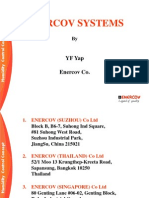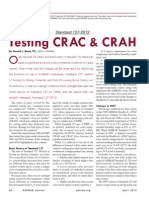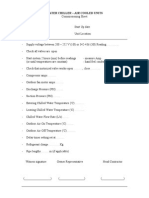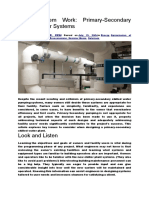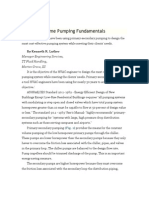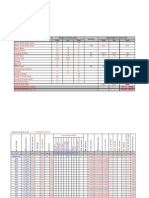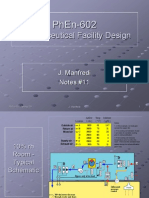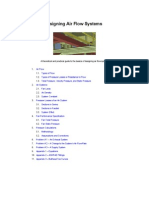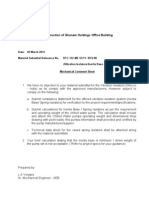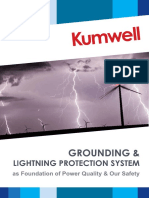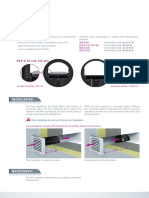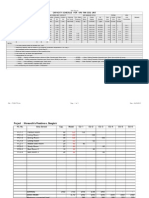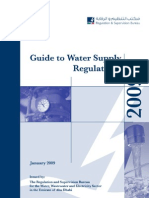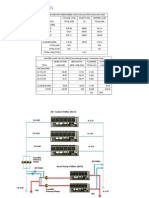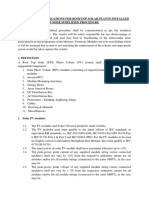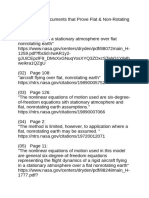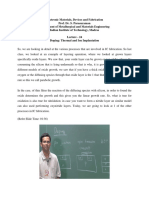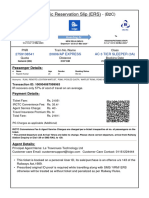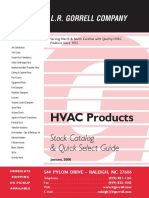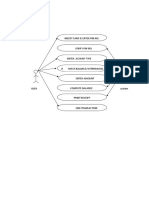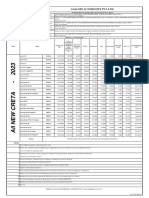Design Control Document-MVAC
Design Control Document-MVAC
Uploaded by
Rudivic LumainCopyright:
Available Formats
Design Control Document-MVAC
Design Control Document-MVAC
Uploaded by
Rudivic LumainOriginal Description:
Copyright
Available Formats
Share this document
Did you find this document useful?
Is this content inappropriate?
Copyright:
Available Formats
Design Control Document-MVAC
Design Control Document-MVAC
Uploaded by
Rudivic LumainCopyright:
Available Formats
THE GATEWAY EKAMAI PROJECT
PRELIMINARY CONCEPTUAL DESIGN MEP SYSTEM
Langham Place
COMPLIANCE ON DESIGN CONTROL DOCUMENT
Prepare By : M&E Engineering 49 Limited
102 4th Flr., Athakravi Building, Sukhumvit 26 Klongton Klongtoey Bangkok 10110 Thailand: www.49group.com Date: 9 March 2010
Compliance on Design Brief for the Langham Place
Item Design Brief GENERAL REQUIREMENTS 1. Provide a centralized heating, ventilating, and air conditioning (HVAC) system with central air handling units to serve public and back-of-house areas and four-pipe fan coil units (or two-pipe cooling with electric heat in locations with mild winters) to serve the guestrooms. Through-the-wall incremental units are not permitted. 2. Locate the air-handling units in mechanical rooms for sound isolation and ease of access. 3. For indoor air quality control purposes, provide double-walled air-handling units so that no sound or thermal insulation is exposed to airflow. The interior chambers of air-handling units and fan coil units should be easily accessible for routine servicing and cleaning. Also provide double-walled ductwork with access for routine cleaning. Specify stainless steel condensate drain pans to positively drain to preclude standing water. 4. Steam may be used for space heating but should be limited to steam-towater heat exchangers. 5. Water-source heat pumps with multiple speed fans may be acceptable in some public or back-of-house locations, but require special attention to the control system and sound isolation. Condenser water to heat pumps should be controlled with automatic constant- flow control devices. 6. The chilled water system consists of centrifugal chillers with water-cooled condensers. High-pressure centrifugal or screw-type chillers using nonCFC refrigerant HFC-134a are preferred. Size the chillers to be efficient at part-load conditions. ME49s Proposed
2.3 Heating, Ventilating, and Air Conditioning (HVAC) System
1. Comply with the exception of using two-pipe system without electric reheat.
2. Comply 3. Comply for double-walled AHU.Double wall ductworks not comply. GI Sheet with fiberglass insulation is specified. Stainless steel condensate drains: not comply, using Gi sheet as per manufacturer specification. 4. N/A 5. N/A
6. Comply except for HFC134a, we proposed to use R123 due to its overall performance aspect in terms of low OPD and low GWP, and produce higher efficiency. Design consideration to have 3 A minimum of two chillers piped in parallel is required, each designed at chillers (40% x 3 units) of the block 65% of peak load. Where three chillers are required, provide flexibility and load capacity. some redundancy by sizing the chillers for 20%, 40% and 60% of the calculated block load capacity. In order to achieve redundancy in the primary chilled water pumping circuit, a spare pump sized for the 60% chillers, but with an adjustable head control valve on the pump discharge, can be used. Designing the chillers and associated pumps for flexibility and part-load operation lowers operating costs, reduces repair and maintenance costs, and results in more comfortable spaces.
1 of 47
Item
Design Brief ME49s Proposed 7. In executing block cooling load calculation consider effects of load 7. Comply variations (occupancies, solar load, etc) to provide a system that has sufficient capacity to meet peak cooling and heating load conditions but does not result in system with recessive amounts of spare capacity. 8. Provide induced, draft-type cooling towers constructed of stainless steel 8. Comply and/or fiberglass to dissipate condenser water heat. Locate the cooling towers to reduce noise impact on adjacent spaces. For indoor air quality control purposes, provide sufficient separation, preferably by distance rather than built feature, so as to preclude cooling tower air discharge from being drawn into ventilation air intakes under certain wind and atmospheric conditions. 9. A primary/secondary system is the preferred chilled water circuit design. 9. Comply, further study shall be conducted in the design of variable primary pump system for consideration. 10. The primary pumping loop of the chilled water system supplies a constant 10.Comply for two-way control valve. Variable primary pump system to be flow through each operating chillier. Control all loads with two-way control studied for consideration. valves connected to a variable flow circulation loop. The design engineer must pay particular attention to how the chilled water control valve proportional positioning algorithm is specified and implemented by the controls contractor. The design temperature rise must be achieved across the supply and return waterside connections under all load conditions in order for the benefits of a primary- secondary system to be achieved, along with proper automatic chillier/pump sequencing operations 11. Provide variable-speed secondary loop pumps. Install a wall-mounted 11.Comply, further study shall be flow meter across the de-coupler section of piping to monitor any flow conducted in the design of variable reversal. Design the system to maintain a minimum differential pressure primary pump system for near the end of any loop and to prevent any control valve from reaching consideration. its close-off pressure rating. Provide air handling or fan coil units at the extreme ends of secondary loops with a three-way control valve in order to maintain a minimum circulation level so that chilled water does not stagnate and warm up during low-load periods. The chilled water usage diversity is approximately 70% for full-service hotels. 12. The combination heating hot water and domestic hot water system 12.We propose using heat pumps for domestic hot water and as a pre-heat consists of gas and/or fuel oil fired hot water boilers with units for supplying water to steam primary/secondary hot water pumping system, expansion tank, air boiler serving kitchens and laundry. separator and shell-and-tube heat exchangers for the heating hot water, domestic hot water, laundry, and kitchen systems. Boiling capacity sized to meet simultaneous peak load for heating domestic hot water, laundry hot water, and kitchen hot water, with adequate spare capacity.
2 of 47
Item
Design Brief 13. In extremely cold climates, baseboard heating may be necessary near large expanses of window. Coordinate their location, appearance, and enclosure with the interior design. 14. High-rise hotels are susceptible during the heating season to building leakage, in which warm interior air, naturally rising through the hotel (stack effect), may leak out of the upper portion of the pressurized hotel. This creates a negative pressure on the lower floors, increasing the undesirable infiltration of cold outside air and causing uncomfortable conditions near doors, loading docks, or other openings and around leaky dampers. To reduce this, elevator rooms should be air-conditioned rather than ventilated. (Consider DX systems as sensible coolers in this application.) Convective heat losses of idle boilers should be also controlled to mitigate the stack effect. Other mitigating measures may include the design of air dampers to minimize leakage and reduce the amounts of air exhaust during cold weather. 15. Equip chilled water, condenser water, steam, and hot water systems with chemical treatment systems that automatically measure and dose treatment chemicals. 16. Specify medium-efficiency, throwaway type air filters. Provide one complete filter change for the initial installation. 17. Design hotel building to maintain positive pressure, maintain environmental requirements (indoor space temperature and humidity conditions in compliance with hotel requirements) and ensure guest comfort. 18. Locate chillers and boiler plant above water table, with appropriate position of protection from flooding. GUESTROOM AREAS 1. In most locations, provide guestrooms with four-pipe fan coil units (FCU's), either vertical units located within the closet footprint with the discharge air ducted to the sleeping space (the preferred approach for both accessibility and noise abatement purposes) or horizontal units concealed above the entry/bathroom ceiling. Provide two-pipe cooling with electric heating only for locations with mild winters. In this case, consider both the guestroom warm-up rate and the overall heating load. In hot and humid climates, incorporate heat-pipe technology into the FCU to improve dehumidification performance. "Through the wall" PTAC or VTAC units are not permitted in guestrooms. 2. 100% filtered and tempered outside fresh air should be ducted directly into the guestroom instead of being drawn from the guestroom corridor. Makeup air quantity should exceed bathroom exhaust air by 5%.
ME49s Proposed 13.N/A
14.N/A
15.Comply
16.Comply 17.Comply
18.Comply
1. Guestroom design using 2-pipe chilled water cooling without heating. Fresh air is pre-treated thru a central unit Energy Recovery Ventilators (ERV).
2. Comply
3 of 47
Item 3. 4.
5.
6.
Design Brief Use a single, digital thermostat to control units where multiple FCU's serve a common area. Provide the FCU with a digital thermostat with three-speed fan (plus off position). A networked digital control system is preferred. Perceptible vibration or water noise is not acceptable. In guestrooms the Noise Criteria curve for fan coils is not to exceed NC30 at low speed, NC35 at medium speed and NC40 at high speed. The control valve (fan coil and air handling units) must close when the unit is turned off. Provide proportioning control valves to achieve optimum comfort control. Provide the heating water circuit with similar differential pressure controls to those described in the general requirements (2.3-1.10). However, for locations with short or mild winters, provide a constant flow system with three-way valves. The heating water temperature is reset using a schedule based upon outside temperatures. Provide a centralized guest bathroom exhaust system. Central roof mounted fans are preferred over individual exhaust fans mounted over each riser. A heat recovery system should be considered in the design for hotels in cooler climates. Specify sheet metal exhaust ducts; drywall shafts or plumbing chases used as plenums are not allowed. Size the fan to move one CFM per square foot of bathroom floor area, but no less than 50 CFM.
ME49s Proposed 3. Comply 4. Comply
Proportional Control valve is specified for units more than 33,000 btu/hr capacity. 5. N/A
6. Comply
Using ASHRAE Standard 62.1, 2007 Prevent sound transmission through the exhaust system in back-to-back or 25cfm/unit (continuous rate) bathroom configurations by providing suitable acoustic lining for the Comply ductwork. PUBLIC AREAS 1. Supply public spaces with conditioned air from single zone or variable air 1. Comply volume (VAV) air handling units. Use multi-zone air handling units (tripledeck design; neutral deck supplied with pre-treated air) for limited applications such as administrative office areas and retail spaces. 2. Provide individual temperature control for each public space (including 2. Comply subdivisions of larger function rooms). When more than one space or room receives air from an air-handling unit, provide a VAV primary airhandling unit with pressure-independent terminal units. The VAV units should fully shut off to prevent over-cooling unoccupied rooms. Zone airhandling units by type of occupancy and time of operation to allow shutdown of the equipment when cooling/heating is not required.
4 of 47
Item
Design Brief 3. Provide fan-powered VAV terminals in public areas where constant air movement is important - such as function spaces and food and beverage outlets. The VAV units should fully shut off during unoccupied periods to prevent over-cooling of rooms. 4. To meet minimum ventilation requirements in large spaces with variable occupancy (e.g. ballroom or exhibit hall) use carbon dioxide sensing in the return air stream. Where heating loads are moderate the VAV terminal units located near the building's perimeter may provide heat using a reheat coil. These units close the air supply completely upon reduced cooling loads. After the space temperature passes through the thermostat's dead band to the heating side of the range, the air supply opens (approximately 30%) to allow space heating to take place. Temperature control is achieved by modulating the control valve of a hot water reheat coil or cycling an electric reheat coil. Carbon dioxide sensing is preferred to using reheat under these conditions. 5. Indoor swimming pool and spa spaces pose a challenge for humidity control. Provide special dehumidification systems for air-handling equipment. Provide stainless steel ductwork exhaust from the pool equipment room. 6. Design air-handling units with an air economizer cycle where practical so that chillers shut off when AHU's are on air economizer and guestroom cooling is not required. This might require the use of a small direct expansion air conditioner for areas with constant cooling loads such as SMART and the Data Centre. Where necessary, provide condenser water "free cooling" system utilizing a plate-and-frame heat exchanger for guestrooms and other spaces served by FCU's to meet cooling loads that cannot be addressed by air-side economizer operations. 7. Utilize 100% outside air factory packaged AHUs for guest corridors; with vertical riser ducts at the egress stairs. From an emission riser, utilize one duct to supply guest corridor and the duct to supply make-up air to guest rooms. BACK-OF-HOUSE AREAS 1. Provide exhaust systems for garage, loading dock, maintenance shops, locker rooms, electric rooms, kitchen hoods, laundries, employee cafeteria and any other areas producing odors, fames or excessive heat and as required by local codes. 2. Kitchen exhaust systems are totally separate and individual and serve only a single kitchen. All ductwork is welded steel, pitched back toward the hood with cleaning access doors every ten feet and at each elbow. No turning vanes or dampers are allowed. Fire insulation, not less than onehour rated (or the minimum required by code), is applied to ductwork. Provide the cooking exhaust fan housing with a drain connection at the
5 of 47
ME49s Proposed 3. Not Comply : Normal VAV without the fan is used.
4. Comply for dividing external and internal zones. Not comply for using re-heat coils.
5. Comply for stainless steel ductwork for exhaust of pool equipment room.
6. N/A
7. Not comply : Guest corridors is supplied with pre-cooled fresh air from the ERVs. same unit supplying the guestroom fresh air. 1. Comply
2. Comply
Item 3.
4.
5.
6.
7.
8.
Design Brief bottom to allow the cleaning solution to manually drain. Provide an exhaust hood with an automatic wash-down system over ranges, grills, ovens, and other grease vapor-producing cooking equipment. This allows the system to supply less conditioned air to occupied areas of the kitchen to meet comfort requirements. Make-up air quantities should be 95% of exhaust air quantities to prevent odor migration to adjacent public spaces. In cold climates the make-up air is tempered and directed inward into the captured air stream to avoid discharging air directly onto food or associates or their workspace. Fan controls are mounted in a control panel near the hood to start and stop the fan as required for cooking operations. Constant water wash and short-circuit make-up air hoods are not acceptable. Exhaust systems for moisture emitting equipment such as steam kettles, steam pressure cookers, brain maries, dishwashers, and pot washers are to be designed with corrosion-proof and watertight ductwork. Where there is no hood or the hood does not adequately extract moisture, provide a moisture separator duct fitting. Pitch the ductwork back toward the hood or equipment for proper drainage of condensation. Mount fan controls in a panel near the hood to allow operation only when needed. Make-up air for these spaces is 95% of the exhaust air quantities to prevent odor migration to adjacent public spaces. The make-up air supply fan will be interlocked with the hood exhaust fan. Comfort conditioning is essential in the hotel laundry. In hot dry climates provide evaporative cooling. A spot-cooling system with controls convenient to laundry employees can minimize cooling requirements. Exhaust air separated from other ductwork should be directly taken from canopies or shrouds over certain such equipment as flatwork ironers or steamers to minimize the cooling load. The make-up air for the tumbler exhaust should be ducted directly to a plenum that encloses the battery of tumblers. Although not preferred for general use, split DX systems may be allowed in limited applications such as the Data Centre, elevator machine rooms, remote buildings of campus-style resort facilities, or where there are no reasonable alternatives. A ceiling hung fan coil unit may be used in addition to air handling units where small temperature zones are required such as at a remote office or storage area. For water cooled ice machines, provide a separate condenser water system that consists of constant volume pumps and a closed circuit cooling tower. One pump is to be standby.
ME49s Proposed 3. For consideration in the Kitchen hood design by the kitchen consultant.
4. For consideration in the Kitchen and laundry design by the kitchen and laundry consultant.
5. Comply.
6. Noted
7. Comply
8. For kitchen consultant design
6 of 47
Item
Design Brief 9. Provide 24 hour air-conditioning in: 9.1 PBS/computer room 9.2. Telephone and equipment room 9.3. A/V equipment room 9.4. Security/Dispatcher GENERAL REQUIREMENTS 1. Provide a complete Building Management Control System (BMCS) for monitoring and controlling the functions and performance of all major building mechanical systems and equipment. The full scope of a BMCS proposed for a hotel is determined in conjunction with LHI Project Team early in the design phase based on engineering application, initial cost, and operational cost/benefit considerations. 2. Design the BMCS for reliability and ease of use by hotel maintenance staff. The system is based on direct digital control (DDC) technology with stand-alone, distributed signal processing to increase reliability and speed of local processing. 3. Provide networked field processing panels at each BMCS equipment location using "peer-to-peer technology. All hardware and software shall be compliant with the latest BACnet open protocol standard or the LonWork standard (or both) or, preferably, standard Internet protocols as such BMCS hardware/software becomes available. Provide a terminal with a color monitor and printer in the Maintenance Office and portable plug-in interface capability at each field panel location. Include software to display a status screen of major systems and equipment. 4. Provide proportioning valves, damper operation, or bi-directional electric motors for equipment controlled by the BMCS. Valve operators on large equipment shall feature an integral manual positioning device. This equipment provides a positive status indication to the system though an airflow or pump-flow sensor. On larger variable-load equipment, control modules employ devices such as a current transformer with analogue input to measure horsepower. In some instances, these control devices will also serve as the status-proving signal. Lighting control for designated hotel spaces shall be based on occupancy sensors with a manual override capability. 5. BMCS-controlled equipment shall provide space temperature control within 1C. Function rooms and offices must incorporate an occupant-adjustable electronic thermostat instead of space sensors alone.
ME49s Proposed 9. Comply : design using chilled water FCU and standby unit of DX Split Units
2.4 Building Management and Control System
1. Comply
2. Comply
3. Comply
4. Comply
5. Comply
7 of 47
Item 6.
7.
8.
9.
Design Brief Coordinate the design of the fire and life safety system with the BMCS design to determine the level of control and integration necessary between the two systems. Likewise, coordinate the requirements of equipment featuring factory-installed controls (e.g. centrifugal chillers) with BMCS requirements. Where economically feasible, integrate guestroom fan coil DDC controls with a BMCS system providing the necessary interface between the two systems. For optimum guestroom comfort, a fan coil unit with a variable speed fan motor and proportioning valve is preferred. [Where the hotel application and cost/benefit prove feasible provide a guestroom "occupancy-sensing" feature with a front desk interface to signal whether the room is rented or available. Where a guestroom with sliding glass patio doors is part of a BMCS occupancy-sensing system, equip the doors with a fan cut-off switch. BMCS ability to perform the energy management functions should include (but not limited to) followings: 8.1. Time of day scheduling 8.2. Calendar based scheduling 8.3. Holiday scheduling 8.4. Temporary schedule override 8.5. Optimum Start/Stay 8.6. Night setback control 8.7. Night setback control 8.8. Peak Demand Limiting 8.9. Temperature Compensated Duty Cycling 8.10. Air Volume Flow Tracking 8.11. Heating / Cooling Interlock 8.12. Hot/ Cold Deck Reset 8.13. Free Cooling 8.14. Hot Water Reset 8.15. Chilled Water Reset 8.16. Condenser Water Reset 8.17. Chiller Sequencing 8.18. Enthalpy Switchover (Economizer) BMCS should provide features like point focus, historical data management, trend logging with graphics visualization, time scheduling, event scheduling, load shedding, totalization, BMS-aided preventative and condition based maintenance, alarm and event management, selfdiagnosis, self-auditing, system security and used authorization, graphical programming language and animated human machine interface.
ME49s Proposed 6. Comply
7. Comply except for the items listed below: - specify for 3 speed FCU
8. Comply
9. Comply
8 of 47
Item
Design Brief ME49s Proposed 10. Critical alarm selectively enabled in a desirable order or priority, or 10. Comply disabled, should be able to be directed to pagers, remote printers, etc. as desirable. GENERAL REQUIREMENTS 1. The reliability and quality of the local water supply largely influences 1. Comply, 1.5 to 2-days storage plus potable water system design features. Provide on-site water storage to one hour for fire protection. sustain periods of unavailability or where required for fire protection. 2. Laundry water and ware-washing equipment shall be softened to maintain 2. Comply. To be cooperated with laundry and kitchen designers. 1 to 3 grains hardness. If the water supply source exceeds 7 grains hardness, the entire potable water system supply shall be softened. If an on-site purification and filtration system is required, confirm the design requirements with LHI Project Team. N/A. Note that the hardness for water supply in Bangkok is 4.6 to 6.7 grains per gallon.
2.5 Water Supply and Distribution
Comply. To be cooperated with In locations where the municipal water supply source is acceptable, the kitchen designers. hotel may require a small reverse osmosis purification system for limited applications (e.g. food service areas and ice machines). 3. Supply pressure shall be between 30 and 80 PSI. High-rise hotels may 3. Comply. require pressure zones and booster systems with variable speed drives to keep within this range. If a rooftop storage tank and gravity feed design is used, level controls for operating transfer pumps will be required. Pressure reducing valve installations (PRV) should feature two valves in parallel selected for 1/3 and 2/3 of the total capacity, respectively. All PRV stations should be designed with a bypass line with a globe valve connected upstream of the upstream isolation valve of the PRV and downstream of the downstream isolation valve of the PRV. For replacement or repair purposes, all PRV stations shall be specified with pressure gauges (and gauge cocks) which should be installed upstream of the upstream isolation valve of the PRV and downstream of the downstream isolation valve of the PRV. 4. The location and quantity of water pressure zones shall be carefully 4. Comply with 2 options: 1) Using self regulating heating evaluated by the plumbing design engineer for optimum system cables instead of recirculation performance, lowered maintenance, and first cost advantage. Each water system. pressure zone shall be designed with redundant hot water heaters. 2) Re-circulate by gravity to ground Where hot water circulation systems serve multiple pressure zones each level hot water tank and pump zone shall feature its own circulation pump and booster heater to isolate it back to roof hot water tank (open from the others. Small circulation pumps are not able to reliably overcome system) the pressure drop of pressure reducing valves serving multiple pressure zones.
9 of 47
Item
Design Brief ME49s Proposed 5. Langham Places brand standards include the Bathworks typical for every 5. As normal practice in Thailand, they usually use main and branch piping guest bathroom shower installation. All aspects of the domestic water system, not the manifold. Note that system should be reviewed by the plumbing design engineer to facilitate 50-60 PSI pressure requirement the pressure and flow criteria for this proprietary shower head installation. causes the system having PRV in The Bathworks assembly features a rainshower showerheads connected every floor. We recommend installing to a common manifold. To facilitate optimum performance of this 50 PSI system to reduce the damage showerhead assembly, a minimum 50 PSI (60 PSI preferred) entering done to other sanitary fixtures. water pressure is required. Comply. In order to accommodate the Bathworks Shower, the mixing valve in guest bathrooms should be specified as high-flow pressure-balancing models, ported for 6 GPM. 6. Hot water heaters may be either instantaneous, direct gas- or steam-fired, 6. For energy saving, we recommend using heat pump with storage tank. or a heat exchanger and storage tank design. LHI requires system redundancy with all hot water heaters. Comply. However, due to the maximum water temperature which heat pump can reach is 60C, instantaneous boost up water temperature will be used for the equipment which need in laundry. This will be cooperated with laundry designer. 7. Separate the laundry water supply system from the main building system 7. Comply. in order to prevent pressure fluctuations during washer filling cycles; consider an open storage tank fill system for the laundry. The temperature at the points of use shall be (as a minimum): � 160F (71C) for laundry � 140F (60C) for food service equipment and kitchens � 120F for all other areas or as required by local codes Comply. To be cooperated with Also, incorporate a laundry water treatment and recycling system in the laundry designers. design or, at a minimum, a rinse water re-use and heat reclamation system. 8. All shower locations such as guestrooms, employee change areas, and 8. Comply. fitness centers require pressure or temperature-compensating mixing valves. 9. All water supplies to equipment and systems shall be controlled through 9. Comply. Back-flow prevention device will be installed at main CW and HW approved back-flow prevention devices to prevent potable system supply pipes to laundry and also at contamination. Hose bibs, hose connections, service sinks, etc. shall be supply pipes for all kitchen equipped with non-removable vacuum breaker devices. equipment. 10. Water distribution piping throughout guestroom floors must be isolated 10.To be discussed. from the building structure with resilient mounts to limit vibration and noise transmission. All shower supply pipes should be secured with resilient
10 of 47
Item
Design Brief ME49s Proposed material-isolated strapping and blocking near the point where the horizontal pipe penetrates the finished wall system. 11. Provide hose bib locations in kitchen areas, mechanical rooms, swimming 11.Comply. pool, and at the building exterior for cleaning walkways, driveways, patios, decks, receiving dock, and trash compactor areas. Such installations must be freeze-proof in colder climates. All hose bibs shall feature integral vacuum breakers or be equipped with an approved backflow preventer. 12. Consider rainwater storage for uses such as flushing toilets, fire protection 12.To be considered. system supply, cooling tower make-up, or landscape irrigation. 13. Grey water usage for flushing or irrigation may be considered if the quality 13.Comply but only irrigation usage. of water meets nationally recommended standards for purity, odor, taste, and clarity. In some cases only limited treatment may be necessary, e.g. primary bioremediation, filtration, and disinfection. GENERAL REQUIREMENTS 1. Confirm the design requirements of an on-site sewage treatment system 1. Comply. Currently, public sewer where public sanitary sewers are not available or a grey water system with system still not available. Package the LHI Project Team. on-site sewage treatment plant shall be provided. However, this plant will serve as primary treatment when public sewage is available in near future 2. Cast iron piping is to be used for sanitary and storm water drainage piping 2. Comply. located within the building envelope in order to limit noise transmission. 3. All pumping systems for sanitary and storm water must have redundant 3. Comply. capacity and feature alternating controls and low- and high-level alarm limits that serve as input signals to the Building Management Control System. 4. Provide a hard-piped roof rainwater overflow system. Roof scuppers are 4. Comply. not to be used for overflow. 5. Provide clean-out access ports for all sanitary horizontal piping runs for 5. Comply. servicing with drain-cleaning equipment. 6. Provide grease traps where required by local authorities or in properties 6. Comply. with sewage treatment facilities. Locate grease traps outside buildings where they can be serviced out of guest view.
2.6 Drainage System
2.7 Electrical Supply and Distribution System
GENERAL REQUIREMENTS 1. The electrical engineer should contact the local utility for information on local conditions, including the: � Frequency and duration of any power outages, brownouts, or phase losses
11 of 47
1. Noted
Item
2.
3.
4.
5. 6.
6. All cables are copper while busways are aluminium. 7. Function rooms, primarily ballrooms and exhibition space, require a mix of 7. Noted and will coordinate with interior power receptacle configurations in terms of voltage and amperage to allow designer and specialist designer such flexibility in room usage, and may require the distribution of temporary as AV specialist. power for major events. Specific function room requirements are elaborated in the individual room descriptions located in Section 3 of this manual. In general, these larger function room spaces should be equipped with power feeders to hook up temporary service to loads such as large lighting trusses/dimmer boards, rear- screen projection set-ups, multimedia productions, large sound amplification systems, arrays of computer set-ups for large scale training programs, exhibit set-ups, etc. These feeders can terminate in the service corridor with fused disconnects and welding-type connectors. Portable load Centers should also be specified for connection to the feeders. Provisions must be made to route temporary power cabling from the service corridor into the banquet space without going through doors. 8. Each guestroom requires multiple outlets for lighting, small appliances 8. Noted and will coordinate with interior such as the coffee maker, hair dryer, iron, mini bar, television, iHome and designer. clock radio, in addition to the guest's laptop computer and other equipment which may be used concurrently. Coordinate power receptacle locations with the interior designer to eliminate visible cords and the need for multiple-gang adapters and extension cords. Provide an easily accessible outlet for guest ironing and housekeeping. These guestroom requirements are further elaborated in the individual room descriptions located in Section
12 of 47
Design Brief � Need for power conditioning to compensate for voltage fluctuations � Available fault current Rate schedule Design the electrical supply and distribution system for reliability. Provide two incoming lines, each capable of meeting the full load requirements of the hotel. Where possible, the incoming feeds should come from different grid areas or zones. Provide an automatic tiebreaker switch to automatically switch all distribution to the active line upon loss of the other line. Ensure that the tripping of fault protection for a branch circuit or a load affects only that circuit or load. Loads or circuits in or near wet areas must be equipped with ground fault protection at the circuit level. The hotel will have many inductive loads (e.g. electric motors, fluorescent lighting, etc.) including many fractional horsepower motors and motors operating at part-load. Therefore, power factor correction capacitors may be required to maintain the power factor consistently above 0.9 of unity. Liquid-cooled transformers are not to use dielectric fluids containing polychlorinated biphenyl (PCB) compounds. Aluminium conductors are not permitted.
ME49s Proposed
2. The underground single/double loops incoming line will be provided depended on the local utility code.
3. Comply
4. Comply
5. Comply
Item
Design Brief 3 of this manual. 9. Design of lighting and lighting control systems for all public areas of a hotel, including the hotel exterior, shall be done by a professional lighting designer (i.e., not a vendor or contractor). Preferred lighting fixture types and their applications are described in the individual room descriptions located in Section 3 of this manual. No quartz type lighting fixtures should be used for general lighting purposes. Exterior lighting and sign equipment should be activated by automatic systems. All decorative lighting fixture selections are to be made by the interior designer or the lighting designer, as appropriate, subject to LHI review and approval. LHI encourages the use of energy efficient lighting in all areas of a hotel property except where accent lighting is required. In hotel guestroom and public areas, where the use of compact fluorescent luminaries is determined to be appropriate to the interior design concept, bulbs must have a minimum color rendering index of 84 and, in switch applications, an instant-on type ballast. A warm color temperature of 2700K is required for all compact fluorescent lamps to emulate the color temperature of standard incandescent lighting. Task lighting shall be capable of producing a minimum of 30 foot-candles on the task being performed. 10. Administrative offices and common areas accommodate multiple personal computers, fax machines, photocopy machines, etc. Neutral conductors feeding distribution panels and connected circuits to such distribution panels are to be over-sized. 11. Special provisions are required for certain computer equipment locations and other sensitive equipment such as the PBX switch in the Data Centre, file servers, point-of-sale system, and others. Step-down transformers feeding distribution panels serving the Data Centre and all other areas housing a substantial amount of electronic equipment are K-rated. Neutral conductors serving multiple electronic equipment loads are to be oversized. The Property Management System file server and workstations, point-of-sale systems and workstations, and Building Management Control System processing panels require dedicated, "clean" power. Under no circumstances is metallic conduit be used for grounding or neutral conductors. 12. Size the distribution system and distribution panels with the following spare level capacities: � Branch circuit panel boards: 25% � Power distribution panels: 15% � Main power panels: 15% � Transformers and feeder circuits: 10%
ME49s Proposed 9. Noted and will coordinate with lighting designer for the provision of power circuiting.
10.Comply
11.Comply
12.Comply
13 of 47
Item
Design Brief
ME49s Proposed
EMERGENCY GENERATOR 1. A diesel engine-driven emergency generator must be provided that 1. A minimum of 8 hours running at full load will be provided. automatically starts upon loss of normal power and connects to emergency loads through automatic transfer switches. The fuel should be stored in an aboveground storage tank with a fuel fill pipe terminating in a location convenient to fuel truck access. Fuel storage capacity is determined in large part by the utility's outage history, code requirements, and critical loadsnormally a minimum of 48 hours running at full load. Considerations for the location of the generator should include noise, vibration, exhaust emissions, and heat removal. 2. Size the generator to provide for safe evacuation of the building under 2. Comply emergency conditions. In addition, consider that some hotel functions must be sustained for extended periods during local or regional power outages when the building is not evacuated. 3. Critical loads connected to the emergency generator required for code 3. Comply compliance, security, life safety, loss prevention, and to maintain essential hotel operations include the following: � Exit corridor emergency lighting � Exit signs � Exit stairwell lighting � Emergency generator and main switchgear room lighting � Front-of-house and back-of-house emergency lights � Data Centre room lighting, receptacles and air conditioning; power to UPS; UPS battery room lighting and ventilation � Lighting and power in Fire Command Centre and SMART � Aircraft warning lights � Smoke exhaust systems where provided � Exit stairwell pressurization systems where provided � One elevator, with automatic switching, and manual override for all elevators (must comply with applicable elevator codes) � Complete fire detection and fire alarm system including security alarms � Complete emergency voice/tone communication system � Power for electromagnetic door hold open devices where provided � Electric fire and jockey pumps � Flood pumps, sump pumps, sewer ejector pumps, and other essential pumps to be defined by hotel operations � One electric outlet in accessible guestrooms � One Property Management System terminal at the front desk and at each food and beverage outlet. � Air compressor for dry pipe sprinkler system where provided
14 of 47
Item
Design Brief ME49s Proposed � Heat trace for sprinkler piping where provided � All powered components of the fire suppression system 4. Where excess capacity exists, equipment desirable to sustaining building 4. Comply and hotel operations may also be supplied with emergency power including: � Heating systems in colder climates � Walk-in coolers and freezers � Kitchen exhaust systems 5. Where non-essential loads are to be powered by the emergency 5. Not applicable generator, a full load calculation of such equipment shall be made. At no time should non-essential loads be permitted to impact generator performance while powering critical loads. Switching to non-essential loads should be automatic and based on selective prioritization. Where the cost/benefit can be justified, consider additional emergency power capacity to support basic hotel operations at remote properties that are subject to hurricanes and may be without power for several days, or where there is a history of power outages. Key operational functions include cooking facilities, the domestic water system, and limited lighting and power to guestrooms. 6. Conductors from the emergency generator and associated automatic 6. Not comply, emergency main distribution board including ATS is transfer switches shall not be routed through the main electrical located at same room. switchgear room or adjacent to normal service bus ducts so as to prevent consequent failure of the emergency distribution system caused by a major failure of any proximate normal distribution system component.
2.8
Fire Suppression System
GENERAL REQUIREMENTS 1. All interior areas and covered exterior areas are to be fully sprinklered 1. Comply. unless specifically noted below. 2. The sprinkler system is to be fed by two independent water connections 2. Regulation in Thailand requires only equipped with suitable back-flow prevention devices. Where the municipal one fire pump with hr water water supply is not reliable, a second on-site water supply shall be reserved, plus 50 cu.m of water provided and, in areas prone to seismic activity, a second private on-site reserved specifically for fire protection water supply is required. in roof tank. Other non reliable source such as water in swimming pool will also be connected to the system. However, we recommended 1 hr water reserved instead of hr as in regulation. 3. In high-rise hotels, the fire pump may be electric motor driven, depending 3. Comply, but we recommended using upon local fire regulations. A jockey pump (not domestic water booster diesel engine driven fire pump pumps) is used to maintain system pressure. instead of motor driven.
15 of 47
Item
Design Brief ME49s Proposed 4. Sprinkler system zones are limited to a single floor or a partial floor, 4. Comply. depending upon the number of sprinkler heads on the floor. 5. LHI standards include the following unless specifically prohibited by 5. Comply. the local authority: � Provide quick-response residential sprinklers in guestrooms. � Locate sprinkler heads in the linen chute and at the top and bottom of elevator shafts. � Equip the Data Centre room with pre-action systems to reduce the risk of incidental activation. � Provide parking garage areas and areas exposed to sub-freezing conditions with an air-pressurized dry design system with proper piping pitches to ensure complete drainage. � Mount K-type hand held extinguishers near any deep fat fryer locations. 6. Unless required by the local authority, LHI does not require the following 6. Comply. areas to be sprinklered: Required by local authority. However, � Elevator machine rooms, main switchgear rooms, and transformer pre-action sprinkler system will be rooms used. � Manufactured walk-in refrigerators and freezers Required by local authority. Dry type sprinkler heads will be used. 7. Comply.
7. The following types of systems are not permitted: � Halon systems in new construction. Existing halon systems should be scheduled for replacement. � Total flooding CO2 systems unless mandated in writing by the local authority. 8. Locate hand held portable fire extinguishers throughout the hotel as 8. Comply. required by local codes. Coordinate the cabinet location and finish with the architect and interior designer. 9. Consult with the local fire department for the location of standpipe and 9. Comply. other system components: � Standpipe hose cabinets in all exit stairways, on the roof, and at other locations. � Exterior standpipe connection at grade. 10. Provide system capability to routinely test the fire pump at the most 10.Comply. remote end of the standpipe system at 125% of full flow capacity.
16 of 47
Item
Design Brief GENERAL REQUIREMENTS 1. Provide state-of-the-art "point addressable" fire detection, alarm, and control system connected to an integrated fire control panel in the Fire Command Room. The location of this room, usually at the hotel's front entrance or receiving area, should be confirmed with the local fire department. In addition, mimic the control panel in the SMART Centre. 2. The central fire control panel provides necessary communications and control functions to permit firefighters to monitor and control relevant building systems and direct building evacuation. Features of the control panel include: � An alarm amplification and speaker system to provide live voice instructions or pre-recorded instruction to any combination of zones (or all zones). � Elevator status indicators to monitor and control the elevators. � Indicators to show the operating status of the emergency generator and the fire pumps. � Alarm to signal operation of the kitchen exhaust hood fire suppression system. 3. Consult with the local fire department to determine whether a separate firefighters telephone communication system is required in exit stairways, elevators, or other locations. 4. The guestroom alarm system includes the following elements: � Hard-wired, two-station smoke detectors with integral audible and visual strobe alerts in each guestroom. � Activating a guestroom smoke detector results in a "pre-alert condition for a definable time period, after which a zone alarm sounds. This pre-alert status activates only the individual guestroom's audible and visual alarms and sends the pre-alert signal to the central fire control panel in the Fire Command Room and the mimic panel in SMART. No other functions are initiated until the time delay period is over. � After the time delay, evacuation alarming is zoned by floors, generally including the alarm floor plus the floor above and the floor below. Unless otherwise required, authorized persons initiate building-wide evacuation only by key-operated switches at the central fire control panel and the mimic panel in SMART. Provide key-operated alarm abort switches in the same locations. 5. Locate smoke detectors in all elevator lobbies, electrical and mechanical spaces, office areas, storage rooms, and in air-handling unit return air ducts.
17 of 47
ME49s Proposed
2.9 Fire and Life-Safety System
1. Comply
2. Comply
3. Fire telephone jack will be required in fire stairs, fire elevator and exit routes as per local standard. 4. � Visual strobe alert will be provided only in disable guestroom. � Comply
� Comply
5. Comply
Item
Design Brief 6. Provide manual pull-stations only at the front desk area, unless required in other locations by the local authority. The pull-station alarm shall continue to activate until shut-off and reset with a key. 7. Install sprinkler zone flow switches at each control valve location to signal the central fire control panel (and mimic panel) of the activated zone. All suppression system isolation valves and sprinkler zone control valves are monitored with switches that transmit a "trouble" alert to the fire control panels when a valve is closed. 8. Provide fire alarm and voice communication systems in accordance with local code requirements and alarm speakers with integral visual strobe alerts in compliance with Disabled requirements. 9. The fire alarm and control system is required to "capture" elevators and return them to the designated "home" floor location or an alternative floor location if the home floor zone has an activated device. 10. Refer to local regulations for special smoke control and shaft pressurization requirements.
ME49s Proposed 6. Comply and refer to local code
7. Comply
8. Comply
9. Comply
10.Comply
2.11 Vertical Transportation
GENERAL REQUIREMENTS 1. A professional elevator consultant is required to design the vertical 1. Noted transportation for hotel guestroom towers, multiple public area levels, or other special areas. 2. In general, provide at least two public elevators for each 100 guestrooms 2. Refer to specific design control document dated 12-11-2009 for with a minimum of two regardless of the room count. Operating criteria Phayathai Project. include: � Passenger elevator service waiting time and handling capacity. Langham Place requires an elevator design that accommodates 1.5 people per room in a business hotel and 2 people per room in a resort at 100% occupancy in a 5-minute peak period. � The average interval between elevator departures from a floor during a heavy-traffic period average waiting time should not exceed 40 seconds. 3. Refer to specific design control 3. Service and freight elevator-operating criteria: document dated 12-11-2009 for � Provide one service elevator for every 200 guestrooms with a Phayathai Project. minimum of two regardless of the room count. � Provide one or more additional freight elevators to serve the kitchen, receiving dock, and function space. Capacity and speed is based on special criteria such as the requirement to move exhibition materials or serve large banquets.
18 of 47
Item
Design Brief 4. Escalators are required where high traffic areas such as a large ballroom or other function spaces are located on floors other than the ground level or where the movement of people between floors might have a negative impact on passenger elevator service. GUEST ELEVATOR DESIGN 1. The public elevator core should be centrally located to the guestrooms and indirectly visible from the registration area. All guestroom elevators require electronic card readers for controlled key card access to reach guestroom floors. 2. The elevator control system shall be a microprocessor-based, nonproprietary system. 3. The maximum size is a 1,600 kg passenger car with clear optimum interior dimensions of 1,800 wide x 1,500 deep x 2,500 high (architect/interior designer to dictate). 4. Provide variable voltage, variable frequency drive traction elevators. Guestroom elevators cannot be hydraulic design unless noted in low-rise structures up to five (5) stories and provided they meet waiting time/interval criteria as noted elsewhere in these standards. 5. The speed of the guestroom elevators should not be less than 2.5m/s for low rise buildings and up to 4m/s for high rise buildings. For skyscrapers (buildings exceeding 40 storeys) higher speed shall be considered. 6. Provide a minimum 1m wide centre opening door with a 2.25m door opening. Provide a heavy-duty high-speed door operator. 7. Lift car and door interior finishes, lightings, etc, shall be recommended and determined by the interior designer. Indicative finishes of various demands are: � Floors: Hard surface flooring such as natural stone, wood and normally as an extension of the lobby finishes. � Wall Base: Wood or natural stone compatible with the floor finish. � Walls: Wood paneling, mirrors, metal panels and similar durable finishes. Wall vinyl is not acceptable. Provide a hand rail on at least the back wall of the cab. � Ceiling: Wood, mirror or metal panels with recessed low voltage down lights as designed by the interior designer / lighting consultant. 8. Provide the following elevator lobby fixtures: � Call Buttons: Stainless steel or bronze finish as determined by the interior designer. The faceplate should incorporate emergency signage, the Phase I fire service key switch, and fireman's phone jacks when required. � Hall Lanterns: Manufacturer's standard with approved chimes for persons with a disability.
19 of 47
ME49s Proposed 4. Will coordinate with Architect designer.
1. Comply
2. Comply 3. Comply, the selection will be based on performance traffic calculation. 4. Comply
5. Comply, the selection will be based on performance traffic calculation. 6. Comply 7. Noted
8. Comply
Item
Design Brief � Hall Position Indicators: Required at the main lobby terminal visible from all car locations. � Fire Service/Security Panel: As required by local code. 9. Car Operating Panels: Langham Place prefers two complete control panels (one on each side of door) in stainless steel or bronze finish to match cab front and car doors and as determined by interior design concept. Layout and nomenclature of the car operating panels shall be reviewed and approved by LHI Project Team. 10. Additional features to be determined for each hotel include: � Related emergency features (e.g. fire service, emergency lighting and power, etc.). � Wiring for card readers for restricting access to specific floors. � "Hands free" emergency telecom unit. � Car position indicator, convenience outlet, and certificate frame. � Fire control and/or security panels. � Automatic self-leveling to bring the car level with the floor landing plus or minus 60mm (1/4") regardless of load or direction of travel. � An emergency stop switch located in the pit. � Anti-nuisance device that correlates passenger loading with the number of car calls registered. � Light ray and retractable safety shoe (or any other appropriate safety devices) which, when interrupted, will cause closing doors to stop and re-open. � An air-conditioning unit (cooling & heating) appropriate for installation in lift car. The design temperature in the lift car shall not exceed that of the lift lobby by more than 1C. � A speaker for background music and the emergency annunciation system. � CCTV connected to security system. SERVICE, FREIGHT AND OVERSIZE ELEVATOR DESIGN 1. The service elevators are separated from the main back-of-house service corridor by a vestibule. 2. Provide microprocessor-based elevator control. 3. Size: minimum 2,000 kg hospital configuration (or as required by special usage). Capacity and size for freight elevators are determined by specific project requirements for exhibits or oversize equipment. 4. Clear cab interior dimensions: 1.7m wide x 2.2m deep x 2.7m high minimum. 5. Speed: � Minimum 2.0m/s for low to medium rise � Minimum 2.5m/s for high rise
20 of 47
ME49s Proposed
9. Noted
10. Comply
1. Note and will coordinated with Architectural designer. 2. Comply 3. Comply
4. Comply 5. Comply
Item
Design Brief 6. Door Size: 1.2m, two speed, side opening, 2.25m to 2.4m high unless special conditions exist. 7. Provide the following hoist way door finishes: � Doors and Frames: Brushed stainless steel � Threshold: Aluminum 8. Provide the following hall fixtures: � Call Buttons: Vandal resistant design with stainless steel finish. � Hall Lantern: Manufacturer's standard. � Hall Position Indicator: None required. � Fire Service/Security Panel: As required 9. Provide the following service elevator cab finishes: � Car Operating Panel: Vandal resistant fixture, one in each car with all necessary operating buttons, service cabinet, phone cabinet, position indicator and necessary verbiage engraved. Finish is brushed stainless steel. Cab front and cab doors finish to match car-operating panels. � Cab Design: Side and rear walls are manufactured with 14 gauge 5WL rigid stainless steel. Top is 12-gauge furniture steel with white reflective finish. Cab also includes two rows of solid oak bumper rails on side and rear walls, resilient rubber tile or stainless steel or aluminum checker plate floor, and recessed vandal resistant fluorescent lighting. 10. Provide these additional features: � A central status monitoring system with CRT terminals in the Engineering office and SMART space. � Related emergency features such as fire service, emergency lighting and power. � Hands free emergency phone. � If hydraulic elevators are used, the cylinders are protected with a sealed PVC outer casing. � Special usage equipment may require additional features or modifications to the above. ESCALATOR DESIGN 1. General criteria for escalators include: � Tread width: Minimum 90cm; prefer 100cm. � Speed: 0.5m/s. � Finishes: As selected by interior designer. Provide glass balustrades for freestanding units. � Vertical Rise: Not to exceed 6m. Maximum Angle: 30
21 of 47
ME49s Proposed 6. Comply 7. Comply
8. Comply
9. Comply
10. Comply
1. Comply
Item
Design Brief
ME49s Proposed
2.12 Linen Chute
MECHANICAL/PLUMBING 1. Provide fire sprinklers for the linen chute where required. 1. Comply POWER/DATA/TELEPHONE 1. Provide an electric interlock so that when one intake is in use, the 1. By linen specialist electronic interlock prevents doors on other levels from being opened
2.14 Low Voltage System
GENERAL REQUIREMENTS 1. Provide a low voltage building infrastructure that will facilitate fully operational hotel property management systems and function area connectivity. The current Langham Place standard is a 25-year AMP Net Connect System. The low voltage infrastructure system generally comprises the following subsystems: Voice, Data, MATV, and CCTV (CCTV subsystem requirements are described in the Security Systems section of these standards). The low voltage infrastructure contractor is responsible for the low voltage cabling, patch panels, voice/data racks, voice/data jack components, TV jack components, and termination. Portable equipment such as workstations, servers, printers, and room enclosures are provided by others. 2. LHIs IT Department provides design standards and technical design input to the infrastructure designer and assistance in the selection of the low voltage contractor. It is recommended that the low voltage contractors work be part of the general contract for a new build or major renovation project. 3. The cabling standard for low voltage system infrastructure is an Enhanced Category 5e. A single 6-strand Multi-mode fibre connects all Intermediate Distribution Frames (IDFs) to the Main Distribution Frame (MDF). LHI IT recommends vertical distribution of fiber cable to IDF locations within the hotel structure and horizontal distribution of Enhanced Category 5e cabling (or better) to cable connection locations. 4. All vital hotel infrastructure systems originate in the hotel Data Centre Room. This room houses the data and telephone infrastructure, the PBX telephone switch, and hotel technology servers. Intermediate Distribution Frames (IDFs) located in the Data Centre Room contain a rack for the hubs, switches, and UPS. COMPUTER TECHNOLOGY 1. LHI requires all properties to install an integrated property system (IPS) enabled property management system (PMS). The IPS is the platform for connecting the property-level computer systems, the PMS, with the worldwide portfolio of systems. The PMS combines industry standard
22 of 47
1. Comply
2. Note
3. Comply
4. Comply
1. Note
Item
Design Brief hardware with proprietary software to manage components for the hotel operations. 2. Langham Place Hotels utilize identified computer systems that include modules for the reservation/front office (PMS), food and beverage point of sales (POS), sales and catering, revenue management (RMS), guest response and defect tracking, facility maintenance, electronic keys, and back-of-house accounting. Each module covers specific operational functions. For example, the reservation/front office module handles checkin, folios, guest history, and accounts receivable. The PMS also provides interface with other property-level systems such as the PBX switch. 3. Latest version of Windows is the primary network operating system. Provide all servers in a single domain. 4. Provide equipment and cable connection locations for IPS and PMS according to the Information Technology (IT) Matrix provided by LHI IT. This IT Matrix describes projected system users by group and identifies the type of equipment and its location and power requirements. 5. LHI has a strategic relationship for the installation, management, and repair of the wide area network (WAN) equipment in all hotels. Contact the service provider identified by LHI IT to coordinate WAN requirements. 6. Provide a CAT5e data drop for each employee time clock throughout the hotel. TELECOMMUNICATION TECHNOLOGY 1. Hotel telecommunication requirements include the hotel telephone, voice mail, and call accounting systems. 2. Telephone consoles that display the name of the guest who is calling are required at such guest contact areas as SMART, the front desk, and restaurants. 3. Telecommunication cabling is required throughout the hotel including guestrooms, administrative, and function areas. 4. Internet protocol telephone for all areas is recommended. GUESTROOM TECHNOLOGY 1. Information regarding the electronic guestroom door locking system is covered in Section 2.17. 2. Guestroom entertainment service includes cable television service and additional, in most locations, Movie on Demand selections. 3. A master antenna signal distribution system (MATV) is required to receive, process, convert, amplify, and distribute broadband VHF, UHF and cable TV signals to all guestrooms and other locations (e.g. suite parlours, fitness centre, hotel bar, Club L, training room, engineering control room, SMART control room and all function rooms) determined by LHI IT. The MATV system installation shall conform to the specifications of the
23 of 47
ME49s Proposed
2. Note
3. Note 4. Comply
5. Note
6. Comply
1. Comply 2. Comply
3. Comply 4. Comply 1. Comply 2. Comply 3. Comply
Item
Design Brief guestroom entertainment system provider-of-choice of Langham Place. 4. Locate the television video rack equipment in the Video Rack Room located adjacent to the Data Centre. This room is best located away from any sound equipment to avoid potential signal interference. The door to this room is equipped with an electronic card key lock for use by the inroom entertainment system provider. 5. The wireless internet infrastructure requires a certified site survey will. Consult with LHI IT to determine property requirements for broadband high-speed internet access for all guestrooms, meeting and public space locations. SPECIAL CONSTRUCTION 1. No data copper runs are to exceed 90m. 2. Termination points, customized to the propertys physical layout, must be clearly labeled by destination, source, and patch panel. 3. The riser system shall be configured with at least 30% spare capacity for voice. 4. The riser system includes one 12-strand multi-mode fiber from each of the Intermediate Distribution Frame (IDF) locations to the Data Centre. 5. Provide trunk cables of RG-11 coaxial cable with at least 89dB of shielding to the roof for satellite dish access. 6. Provide a 120V AC outlet at each designated amplifier location. 7. Provide dedicated patch cables from the telephone company demarcation point to the Video Rack (MATV) room. These lines are un-terminated and labeled with 7.6m of excess cable on each end. GENERAL REQUIREMENTS 1. Hotel location and physical layout are critical to determining hotel security system requirements. 2. Security alarm, paging, and camera systems (CCTV) shall be monitored in the SMART and/or Security Office room. SECURITY ALARM SYSTEM 1. Provide a hotel security alarm system with the capability to be monitored 24-hours a day by trained hotel associates. 2. Locate a silent duress alarm switch at the following minimum locations: � General Cashier office � Director of Human Resource office � Concierge stations that are remote from the main lobby 3. Silent duress alarm switches shall activate an audible alert and a visual alert on a main control panel in the SMART Room and the Security Office
24 of 47
ME49s Proposed 4. Comply
5. Comply
1. Comply 2. Comply 3. Comply 4. Comply 5. Comply 6. 220V AC will be provided. 7. Comply
2.15 Security System
1. Comply 2. Comply
1. Comply 2. Comply
3. Comply
Item
Design Brief 4. Perimeter fire exit doors and other exterior doors that are not normally used shall be equipped with door contact alarms that release following 30 seconds of applied pressure or on activation of the fire alarm system. Alarms will be transmitted to the SMART Room. Locate supplemental duress alarms, motion detectors, and door contacts as may be required by the hotel location and layout. RADIO & PAGING SYSTEM 1. Provide a communication and pager system, without dead spots, for routine communication among hotel associates. A base station and repeater antenna system is needed to support two-way FM radio communication and a pager system. 2. Provide radio base stations in the: � Security office � SMART Room � Maintenance office 3. Provide a charger rack for the communication and pager system in the SMART Room. CCTV SYSTEM 1. Provide a closed-circuit security camera system (CCTV) for continuous 24hour monitoring of the property. LHI IT will provide a list of acceptable camera system manufacturers. 2. Locate the camera control system and video capture and digital recording system with time lapse recording capability in the SMART Rooms. 3. Provide color cameras and monitors for the CCTV system. Where appropriate, cameras feature pan, tilt, and zoom capabilities. Certain cameras, such as those at the receiving dock and parking facilities, require lenses suitable for low light levels. Motion sensors control the transmission from certain cameras such as at the hotel parking entry vestibule. 4. Coordinate dome enclosures at fixed camera locations with the interior design. 5. Provide a video capture and digital recording system (preferable internet protocol type with WAN capability) with time lapse recording capability. 6. Provide CCTV security cameras at the following locations as a minimum: � Perimeter fire exit doors and low-use perimeter doors � Loading dock � Associate entrance � Registration pods � Public elevator lobby � Count room (cash drop deposit boxes) � Parking facility entry vestibules
25 of 47
ME49s Proposed 4. Comply
1. Comply
2. Comply
3. Comply
1. Comply
2. Comply 3. Comply
4. Comply 5. Comply 6. Comply
Item
Design Brief ME49s Proposed � Guest safe deposit boxes (boxes only) � Data Room � Escalators � Receiving dock and parking facilities 7. Provide a CCTV camera at each door equipped with an electromagnetic 7. Comply hold-open device and display the image in the SMART room when the door switch is activated. MECHANICAL/PLUMBING 1. Provide a remote thermostat for the heating, ventilating, and air conditioning (HVAC) system in the bedroom area, preferably on the bathroom-demising wall, easily accessible and visible to hotel guest. 2. Position the vertical fan coil supply grille so that it neither interferes with the window treatment nor blows across the head of the bed. 3. Where fan coil units are used, the Noise Coefficient (NC) is not to exceed 30NC at low speed, 35NC at medium speed, and 45NC at high speed. 4. The finish of any HVAC grilles and access panels must be color coordinated with the guestroom interior design. 5. No exposed piping is permitted within a guestroom. POWER/DATA/TELEPHONE 1. Provide a sufficient number of power/data/telephone receptacles and wall switches coordinated with the guestroom-furnishing plan so that electrical cords are concealed from guest view. Provide a duplex CAT5e electrical outlet for the refreshment centre that is typically located within the guestroom console unit. Alternatively provide a frequency-coordinated splitter from an existing cable TV location for this purpose. 2. Provide at least one easily accessible convenience outlet for cleaning by room attendants and for ironing by guests, generally in the bedroom area. 3. Provide two telephone jacks, one at the bedside and the other at the desk work area, with two lines to allow the guest to talk on the telephone while simultaneously checking e-mail. Provide high-speed internet access broadband solution in 100% of guestroom, either wired or wireless. Preferred data outlet at desk is a quad outlet with 2 - line internet protocol phone, CAT5e 1 line analogue fax and a CAT5e data port. Locate the quad above the desk surface level. Locate power for laptops in built-in "pop-up" receptacle in desk or return 4. Provide television jack and outlet for (minimum) 37 Plasma or LCD flatscreen television. Confirm latest television brand standard with LHI Operations. 5. Provide outlet for DVD player.
26 of 47
3.2 Standard Guestroom
1. Comply, Cooling only
2. Comply 3. Comply 4. Comply 5. Comply. 1. Comply and according to Interior design
2. Comply and according to Interior design 3. Comply and according to Interior design
4. Comply and according to Interior design 5. Comply and according to Interior design
Item
Design Brief 6. Provide outlet for iHome (located on the nightstand).
ME49s Proposed 6. Comply and according to Interior design 7. Provide one smoke detector per guestroom, two-station hard-wired that 7. Comply and according to Interior design sounds a local alarm in the guestroom and is annunciated at the Fire Command Centre and at the SMART Command Centre. This unit is to provide a trouble indication if the detector is removed or is not reporting. 8. Offset outlet boxes a minimum of 150mm and separate with a stud to 8. Comply and according to Interior avoid back-to-back power, data, or telephone outlets. design 9. Each light fixture is UL-rated and labeled and certified for the wattage that 9. Light fixture spec will be according to will be carried. Verify that the light fixture, lampshade, saddle, harp, Interior design. socket, and power rating are compatible. 10. Provide a variety of guestroom lighting sources: foyer wall sconce or 10. Comply and according to Interior downlight, bedside sconces or nightstand lamps, desk lamp, and floor design lamp. Provide the following minimum light levels (measured at the task being performed): � Foyer illumination: 10 FC from downlight with halogen or wall sconce with CFL (32W+) � Bedside task lighting: 30 FC from nightstand lamp with CFL (32W+) � Desk work surface task lighting: 50 FC from desk lamp with CFL (32W+) � Lounge chair task lighting: 30 FC from floor lamp with CFL (32W+) � Closet: 10 FC. Provide a separate light fixture in the closet if the entry lighting does not provide the required illumination in the closet. 11. When compact fluorescent light fixtures are used, bulbs must have a 11. Comply and according to Interior design minimum 30W rating, a high color rendering index, and an instant-on type ballast. A warm color temperature of 2700 K is required for all compact fluorescent lamps. 12. All 3-way incandescent rated lamps shall have 3-way light bulb installed in 12. Comply and according to Interior them. design 13. All ceiling mounted lights / light fixtures to be dimmable. 13. Comply and according to Interior design MECHANICAL/PLUMBING 1. The bath is a minimum 1,500mm long x 800mm wide, enameled cast iron 1. By architect/interior designer. with a non-slip bottom. Plastic, acrylic and fiberglass tubs or showers are not acceptable. 2. Tub and vanity fixtures have overflow outlets and pop-up type waste 2. By architect/interior designer. stoppers. 3. The sink is vitreous china or enameled cast iron. The faucets are 200mm 3. By architect/interior designer. on Centre, style selected by the interior designer.
27 of 47
3.3 Standard Guest Bathroom
Item
Design Brief ME49s Proposed 4. The toilet is a floor mounted vitreous china tank type with an elongated 4. By architect/interior designer. bowl. The seat is to have a closed front and a lid. The seat and lid must remain in an upright position without being held. A fully compartmentalized toilet is desirable. 5. The Bathworks Shower uses rainshower type shower head connected to a 5. In Thailand, they usually use main and branch piping system, not the common manifold and requires water pressure of between 50 and 60 PSI. manifold. Note that 50-60 PSI The shower control is a single-handle, pressure-balanced mixing valve pressure requirement causes the rated for high flow. system having PRV in every floor. We recommend installing 50 PSI system to reduce the damage done to other sanitary fixtures. 6. The Bathworks Bath specifications require the faucet to be positioned in 6. By architect/interior designer. the middle of (one of the long sides of) the bath and not at one end. 7. The bathroom exhaust fan is to have noise rating not to exceed 45NC. 7. Comply POWER/DATA/TELEPHONE 1. Provide at least one ground fault interceptor (GFI) duplex outlet above the 1. Comply and according to Interior design lavatory counter in the bathroom. This receptacle shall have a dedicated circuit to accommodate an 1800+ watt hair dryer without tripping the circuit breaker. Provide a separate hardwired illuminated make-up mirror on the wall adjacent to the vanity. 2. Each light fixture is UL-rated and certified for the wattage that will be 2. Light fixture spec will be according carried to Interior design 3. Illuminate the guest bathroom using a combination of downlights and two 3. Comply and according to Interior pendant fixtures or wall sconces at each side of the mirror. Provide the design following minimum light levels (measured at the task): � General illumination: 30 FC from downlight with CFL (32W+) � Bathtub: 10 FC from downlight with CFL (32W+) � Vanity mirror: 50 FC from pendants or sconces with CFL (32W+) 4. One telephone jack for an analogue telephone 4. Comply and according to Interior design MECHANICAL/PLUMBING (same as standard guestroom and bathroom or better) 1. Provide an underhung stainless steel bar sink with decorative gooseneck 1. By architect/interior designer. faucet at the pantry. 2. Provide typical HVAC module fan-coil systems in suites; install a single 2. Comply control where more than one unit is used in a multi-bay space.
3.4 Guest Suites
28 of 47
Item
Design Brief POWER/DATA/TELEPHONE (same as standard guestroom and bathroom or better) 1. The interior designer is responsible to select all general lighting (recessed downlights, wall washers) and decorative lighting (chandeliers, sconces). 2. Provide a secondary light source in the ceiling away from the vanity in all suite bathrooms over 5 SQM in area. 3. Provide throughout the Meeting Suite a minimum illumination level of 10 FC, measured at the floor. 4. Provide decorative lamps and light fixtures throughout each suite to give a minimum 30 FC at the desk, dining table, and soft seating areas. 5. Provide a wall sconce, surface mounted ceiling fixture, or recessed downlight in each suite entry, controlled by a switch at the entry door. 6. Provide an easily accessible convenience outlet in the parlour or meeting area for use by housekeeping. 7. Provide a GFI outlet at each wet bar or pantry location. 8. In each luxury suite parlour, provide a television jack and electrical receptacle for a wall-mounted 42 Plasma or LCD screen television. Coordinate placement and height with the interior designer. (The suite bedroom has the standard 37 Plasma or LCD television.) 9. Provide television jack and electrical receptacle for in mirror television in bathroom. 10. Provide two IP Phones with message warning lights in each suite parlour. One telephone must have a built-in data port; one should be cordless. 11. Provide a wall-mounted telephone in the pantry.
ME49s Proposed
1. Comply and according to Interior design 2. Comply and according to Interior design 3. Comply and according to Interior design 4. Comply and according to Interior design 5. Comply and according to Interior design 6. Comply and according to Interior design 7. Comply 8. Comply and according to Interior design
9. Comply and according to Interior design 10. Comply
11. Comply and according to Interior design 12. Provide stereophonic Bose stereos (or equivalent standard), premium 12. Comply and according to Interior design guest suites according to market requirements. The stereo system speakers should be connected to all bays with independent volume controls in each bay.
3.5 Accessible Guestrooms and Suites
MECHANICAL/PLUMBING (SAME AS STANDARD GUESTROOM OR BETTER) 1. Locate controls, such as the thermostat, on an accessible route, within the required reach range, capable of being operated with a closed fist (e.g. toggle switch or push button); twist knobs are not acceptable. 2. The height to the top of the toilet seat is 430mm above the floor. The centerline of the toilet must be located exactly 457mm from the finished wall. The flush mechanism must be on the open (approach) side of the toilet. 3. Provide seating in tubs and showers as required. Note that seats in showers must be located so that a seated person may operate the
29 of 47
1. Comply, for further coordination with Interior Design 2. By architect/interior designer.
3. By architect/interior designer.
Item
Design Brief controls. 4. Provide a hand-held shower wand on an adjustable slide bar at least 760cm long and mounted no lower than 600mm above the tub or shower floor. Shower units must be removable from the bar and have a minimum 1,500mm-long hose. 5. Mount the mirror so that the bottom edge is no higher than 1,000mm AFF. POWER/DATA/TELEPHONE 1. Locate switches and outlets within the required reach range and of a design that guests can operate with a closed fist. Handles, pulls, latches, locks and other operating devices shall have a shape that is easy to grasp with one hand and does not require tight grasping or twisting of the wrist to operate. Lever operated mechanisms, push-type mechanisms, and Ushaped handles are acceptable designs. 2. Locate receptacles for guest use on an accessible route and within the required reach range. Provide an accessible outlet within 1,200mm of the phone for use with a TDD. 3. Provide phones with a volume control and a light to indicate incoming calls.
ME49s Proposed 4. By architect/interior designer.
5. By architect/interior designer. 1. Comply and according to Interior design
2. Comply and according to Interior design 3. Comply and according to Interior design
3.6 Club L
MECHANICAL/PLUMBING (same as standard guestroom or better) 1. Provide a single thermostat to control the multiple heating, ventilating, and air conditioning (HVAC) units throughout the space. POWER/DATA/TELEPHONE (same as standard guestroom or better) 1. Provide house and credit card phones; also provide a telephone and data port outlet at the work desks and at other locations where guests might use a laptop computer. 2. Provide a minimum general illumination of 10 FC throughout Club L, measured at the floor. 3. Provide decorative lamps or other lighting throughout the Club L to assure 30 FC at lounge seating, work areas, and the buffet. 4. Provide power as required for fax/copier/printer and personal computer equipment. 5. Provide internet access points for internet station. 6. Provide power as required in the pantry and at the buffet for specified equipment. 7. Provide a sufficient number of wall and floor outlets, coordinated with furniture plans, so that electrical cords are concealed from guest view. 8. Provide easily accessible convenience outlets for use by room attendants when cleaning the room. 9. Provide GFI outlets at the buffet, in the powder room, and at the pantry.
30 of 47
1. Comply
1. Comply and according to Interior design 2. Comply and according to Interior design 3. Comply and according to Interior design 4. Comply and according to Interior design 5. Comply 6. Comply and according to Interior design 7. Comply and according to Interior design 8. Comply and according to Interior design 9. Comply and according to Interior design
Item
Design Brief ME49s Proposed 10. Provide system-connected smoke detectors that sound a local alarm and 10. Comply are annunciated at the Fire Command Centre and at SMART. Each unit is to provide a trouble indication, if the detector is removed or not reporting. MECHANICAL/PLUMBING (N/A) POWER/DATA/TELEPHONE 1. Select decorative wall sconces or ceiling mounted fixtures with CFL lamping to provide a minimum lighting level of 20 FC measured at 1,500mm AFF at each guestroom entry door. Recommended general corridor lighting level is 15 FC with no dark spots. Minimum illumination level is 5 FC. 2. Provide recessed down lights, decorative fixtures, or a combination of both in the elevator lobby. 3. Provide electrical outlets every 12m in the corridor for housekeeping purposes. 4. Provide one (1) house telephone outlet and one (1) duplex electrical outlet at the console table in each elevator lobby.
3.7 Guestroom Corridor and Elevator Lobby
1. Comply and according to Interior design
2. Comply and according to Interior design 3. Comply and according to Interior design 4. Comply and according to Interior design
3.8 Ice Machine Alcove
MECHANICAL/PLUMBING 1. Locate the floor drain for the ice machine condensate out of the guest walk area. 2. Provide a cold-water shutoff valve at each ice machine. 3. Mechanically exhaust the area to remove heat from the equipment. 4. For water-cooled ice machines, provide a separate condenser water system that consists of constant volume pumps and a closed circuit cooling tower. POWER/DATA/TELEPHONE 1. Provide fluorescent lighting to give a minimum of 20 FC at floor level. Lighting is on an unswitched circuit or controlled by a motion detector. 2. Provide a GFI electrical outlet for each piece of equipment. 1. Comply 2. Comply 3. Comply 4. Proposed to use evaporative coils
1. Comply and according to Interior design 2. Comply
3.9 Guestroom Level Electrical and Telephone Closets
MECHANICAL/PLUMBING 1. Provide ventilation in the rooms to maintain room temperatures within 1. Comply acceptable limits for equipment specifications. POWER/DATA/TELEPHONE 1. Provide lighting to maintain 25 FC at 1,500mm AFF. 1. Comply and according to Interior design 2. Provide each standard guestroom and each guest bathroom with its own 2. Comply and according to Interior 20A, 120V / 240V circuit (separate circuits). Confirm that the hair dryer design and coffee maker are on separate circuits.
31 of 47
Item
Design Brief ME49s Proposed 3. Provide individual circuits for service appliances and mechanical 3. Comply equipment with loads over 900W. MECHANICAL/PLUMBING 1. Where dictated by market and climate, integrate radiant heating units into the porte cochere ceiling design. POWER/DATA/TELEPHONE 1. The minimum lighting level under the porte cochere is 30 FC at ground level utilizing decorative or downlight fixtures. 2. Provide power, data, and telephone for the valet pod and cashier window locations. 3. Provide a professional quality background music zone (music provided by LHI approved music vendor) within the porte cochere area. Locate speakers so sound is apparent to arriving guests. Locate speakers discreetly to tie into the exterior architectural concept.
4.1 Porte Cochere
1. N/A
1. Comply and according to Interior design 2. Comply and according to Interior design 3. Comply and according to Interior design
4.2 Lobby
MECHANICAL/PLUMBING (N/A) POWER/DATA/TELEPHONE 1. Requirements for the lobby ATM include a 15" minimum size colour screen, a thermal printer, smart card and magnetic stripe reader. The ATM is to be secured to the wall or floor and is front-loaded. 2. Provide floor electrical, data, and telephone outlets for seating areas and for pod stations. Coordinate outlet locations carefully with the interior design furniture layout. House phones are distributed throughout the lobby. 3. Coordinate the location of electronic information screens with the interior and electrical design. 4. Provide a minimum of 15 FC illuminations in the lobby using a variety of decorative and recessed fixtures. Provide a dimmer system with four preset scenes controlled at the registration area. 5. Provide outlets for housekeeping and maintenance at no more than 9m intervals. 6. Provide a professional quality background music zone (music provided by LHI approved music vendor) within the lobby. Locate speakers so sound is apparent to arriving guests.
1. Comply and according to Interior design 2. Comply and according to Interior design
3. Comply and according to Interior design 4. Comply and according to Interior design 5. Comply 6. Comply
4.3 Registration Pods and Related Areas
MECHANICAL/PLUMBING (N/A) POWER/DATA/TELEPHONE 1. Provide 50 FC lighting at the pod work surface.
32 of 47
1. Comply and according to Interior design
Item
Design Brief ME49s Proposed 2. Each agent station in a pod has two data and two telephone outlets and a 2. Comply and according to Interior design fourplex electrical outlet. Each printer station has a data outlet and a duplex electrical outlet. All of these connections are accessed through floor outlets and are coordinated with the interior design and millwork drawings. 3. Provide a fixed, wall mounted CCTV camera to view each point-of-sale 3. Comply terminal. MECHANICAL/PLUMBING (N/A) POWER/DATA/TELEPHONE 1. Coordinate electrical outlets with any furniture or decorative lighting.
4.4 Guest Elevator Lobby
1. Comply and according to Interior design 2. Provide a minimum of 10 FC illumination in the elevator lobby using a 2. Comply and according to Interior combination of decorative and recessed ceiling fixtures. design
4.5 Public Restrooms
MECHANICAL/PLUMBING 1. Locate floor drains in a discreet location away from guest travel paths. 2. Fixtures, including water closets, urinals and sinks are white finish. 3. Lavatories shall be single centre hole faucet designed with electronic controls in new construction. 4. Provide automatic flush valves and urinals in new construction. POWER/DATA/TELEPHONE 1. Restroom lighting should provide 25 FC illumination with a combination of decorative wall fixtures and recessed compact fluorescent downlights. 2. Provide a professional quality background music zone (music provided by LHI approved music vendor). 1. Comply 2. By architect/interior designer. 3. By architect/interior designer. 4. By architect/interior designer. 1. Comply and according to Interior design 2. Comply
4.6 Specialty Retail Shop (Hotel Operated)
MECHANICAL/PLUMBING 1. Provide positive exhaust for heat generated from the refrigerator and/or 1. Comply freezer unit. 2. Provide local thermostat control for heating and air conditioning. 2. Comply, cooling only POWER/DATA/TELEPHONE 1. General lighting level is a minimum of 30 FC measured at 900mm AFF. 1. Comply and according to Interior design 2. Cabling for Point-of-Sale (POS) equipment shall be provided in flush floor 2. Comply and according to Interior design outlets where required by the store layout.
33 of 47
Item
Design Brief MECHANICAL/PLUMBING 1. The specialty shop requires a fully automatic sprinkler system equal to the building standard for public space. The tenant will bear any additional costs involved in adapting this system to the tenant space. 2. The HVAC system shall be equivalent to the HVAC system provided in the public areas of the hotel. The tenant will bear the cost of revising installed systems or additional costs involved in adapting a system to a tenant space. 3. If required, 20mm hot and cold water supply and 100mm sanitary waste and vent lines will be brought to the perimeter of the tenant space. POWER/DATA/TELEPHONE 1. Junction boxes will be provided in the ceiling, matching the quality, quantity and configuration of standard ceiling lighting in adjacent areas of the hotel. 2. Electrical power will be brought to a panel at the perimeter of the store space. Electrical system circuit capacity will be equivalent to one 100 220 volt, single-phase, 15-amp circuit per 10 SQM. If desired, 208-volt service will be provided at the perimeter wall at additional cost to the tenant. 3. One 25mm telephone conduit will be provided at the perimeter wall of the shop space. 4. A fire alarm system circuit will be provided at the perimeter wall of the shop space.
ME49s Proposed
4.7 Specialty Retail Shop (Third Party Operated)
1. Comply
2. Comply
3. Comply
1. Comply
2. Comply
3. Comply 4. Comply
4.8 Business Centre
MECHANICAL/PLUMBING (N/A) POWER/DATA/TELEPHONE 1. Provide power receptacles and outlets for the office equipment similar to 1. Comply and according to Interior the sample layout. design 2. Provide a light level of 50 FC at 750mm AFF. 2. Comply and according to Interior design
5.1 Portal Work & Play (Hotel Bar)
MECHANICAL/PLUMBING 1. Provide floor drains and sinks in the bar service area as required by 1. Comply equipment design. POWER/DATA/TELEPHONE 1. Provide a minimum 15 FC illumination using a combination of downlights, 1. Comply and according to Interior design low voltage accent lighting, and table and floor lamps. Lighting shall be dimmable with a four-scene preset control. Locate dimmer controls at the bar.
34 of 47
Item
Design Brief ME49s Proposed 2. Coordinate wall and floor receptacles with the furniture and lighting 2. Comply and according to Interior locations. design 3. Provide wireless broadband access in 100% of bar seating areas. Locate 3. Comply high quality, tasteful signage complimenting the interior design concept in the lobby that describes this service. DESIGN MECHANICAL/PLUMBING (N/A) POWER/DATA/TELEPHONE 1. Provide a point-of-sale (POS) system with terminal, printer, and cash drawer at designated server stations. 2. Provide a self-contained sound system within the restaurant space. 3. Lighting shall be incandescent type to complement the interior design. Provide a minimum 20 FC illumination in the restaurant space. 4. Provide a local dimming system with multiple pre-set scene functions. Locate the controls at the host stand or a service station out of guest view. 5. Provide a telephone connection and built-in lighting at the host stand. If a freestanding unit, coordinate the location of the conduit in the floor with the design of the millwork.
5.2 The Place - All Day Dining
1. Comply and according to Interior design 2. According to AV specialist designer 3. According to AV specialist designer 4. According to AV specialist designer
5. Comply
5.3 Specialty Restaurant
MECHANICAL/PLUMBING (N/A) POWER/DATA/TELEPHONE 1. Provide a point-of-sale (POS) system with terminal, printer, and cash 1. Comply and according to Interior designer drawer at designated server stations. Provide a terminal and printer location at the bar if part of the restaurant concept. If the specialty restaurant is operated as a concession, review POS interface requirements for compatibility. 2. Provide a self-contained sound system within the restaurant space. 2. Comply and according to Interior designer 3. Provide a local dimming system with multiple pre-set scene functions. 3. Comply and according to Interior Locate controls at the host stand or a service station, out of guest view. designer 4. Provide telephone and lighting at the host or maitre d stand. If 4. Comply and according to Interior freestanding, coordinate conduit location and termination within the designer furniture design. 5. Provide a minimum light level of 20 FC with incandescent lighting to 5. Comply and according to Interior complement the interior design. designer
5.4 Secondary F&B Outlet
MECHANICAL/PLUMBING 1. Provide floor drains or floor sinks as required by code.
35 of 47
1. Comply
Item
Design Brief
ME49s Proposed
POWER/DATA/TELEPHONE 1. Provide a point-of-sale (POS) system with terminal, printer, and cash 1. Comply and according to Interior drawer at designated server station(s). designer 2. Provide a house telephone at the "Grab and Go" facility. 2. Comply and according to Interior designer
6.1 Pre-function Area
MECHANICAL/PLUMBING (N/A) POWER/DATA/TELEPHONE 1. Coordinate data and power outlets with furnishings, computerized event 1. Comply and according to Interior directory, and telephone counter locations. designer 2. Provide high-speed Internet connectivity broadband solution in locations 2. Comply throughout the pre-function area as located by LHI IT. 3. Provide a minimum of 15 FC illumination in the pre-function area through 3. Comply and according to Interior a combination of decorative and recessed architectural lighting. designer
6.2 Ballroom
MECHANICAL/PLUMBING 1. Provide each section of the ballroom with individual temperature control for heating, ventilating, and air conditioning. 2. Ceiling ductwork should provide individual ducts for each divided section of the ballroom to prevent sound transmission from section to section. Lay out the ductwork, where possible, to avoid passing through the partition above an operable wall. Where penetration is necessary, fabricate acoustically treated sound traps with two 90 bends. 3. Noise generated by mechanical equipment is not to exceed NC-30. POWER/DATA/TELEPHONE 1. Provide receptacles for power, data, and telephone as noted on the diagram. 2. Provide a wall mounted phone, 1,200mm AFF, at one entry to each subdivided space. Upon client request, these phones shall have access to outside lines. 3. Provide a fully operational hotel A/V system in the ballroom (see section 2.13). The A/V system shall have the capacity for general distribution and independent localized sound within each subdivision of the ballroom, and provide background music and speaker amplification as required. Each section can be used independently or in a combined configuration. 4. Provide an A/V panel (Panel Type 1) in each ballroom section. 5. Provide two sound and light rooms for a ballroom over 1,400SQM, one for each dimension. 6. Provide a minimum of 20 FC when social events are held in the ballroom without fluorescent lights on. This is usually accomplished by incandescent
36 of 47
1. Comply 2. Comply
3. Comply 1. Comply and according to Interior designer 2. Comply and according to Interior designer 3. According to AV specialist designer
4. According to AV specialist designer 5. According to AV specialist designer 6. Comply and according to Interior designer
Item 7.
8. 9.
10.
11.
12. 13.
14.
15.
Design Brief decorative and architectural lighting. Provide a minimum of 40 FC when meetings are held in a ballroom. This is accomplished with the supplemental or primary use of fluorescent lighting. Use metal halide or halogen only when the ceiling is over 6,000mm-high. Architectural lighting fixtures should be low brightness with 45-degree angle shielding. Provide a dimming system, including individual wall boxes, multi-scene presets, and interconnected and portable remote control capability for each ballroom space. Each ballroom subdivision requires a fully dimmable incandescent system and a fluorescent system controlled by switches. Decorative chandeliers and sconces, incandescent and fluorescent downlights, and individually controlled track lights at each head table location must be on separate circuits. Provide a 400-amp 120/208-volt 3-phase distribution panel per each 280SQM of ballroom. Each 400A panel includes one (1) 50A, two (2) 75A, and one (1) 200A line. Provide the 200-amp with a cam lock distribution system to facilitate industry standard entertainment power cable systems. The preferred access entry to the ballroom from the service corridor for this distribution panel is via a hinged "doggie-door panel" or pass-through opening. Locate the control switch for the operable partition where the operator can see the partition. Floor outlets and raised flooring systems are discouraged. However, in large ballrooms provide power and A/V floor boxes on each side of the major divisible partitions. At subdivided ballroom areas over 140 SQM, provide adjustable track light accent lighting to head table/podium/buffet locations. Provide two separate 8 long strips of track lighting in the ceiling at these head table locations, preferably with two separate circuits for flexibility and light setting. Provide high-speed internet access broadband solution in all ballroom areas as part of 100% meeting area connectivity requirement for hotel.
ME49s Proposed 7. Comply and according to Interior designer
8. Comply and according to Interior designer 9. According to AV specialist designer
10. According to AV specialist designer
11. Comply
12. According to AV specialist designer 13. Comply and according to Interior designer 14. Comply and according to Interior designer
15. Comply
6.3 Meeting Rooms
MECHANICAL/PLUMBING 1. Provide each meeting room or section of a meeting room with individual 1. Comply temperature control for heating, ventilating, and air conditioning. Meeting rooms are designated smoke-free areas. 2. A constant comfortable air temperature (recommend 70F) shall be 2. Design room condition at 73F reached 30 minutes prior to the function and maintained throughout the
37 of 47
Item
Design Brief
ME49s Proposed
function. 3. Ceiling ductwork should be designed to prevent sound transmission from 3. Comply meeting room to meeting room. 4. Noise generated by meeting room mechanical equipment is not to exceed 4. Comply only if the unit is isolated NC-30. outside the room. For further discussion. For large AHU is possible but for FCU may be difficult. POWER/DATA/TELEPHONE 1. Provide power, data, and telephone receptacles. (Exhibit 11.12) 1. Comply and according to Interior designer 2. Provide a wall-mounted phone, 1,200mm AFF, at one entry in each 2. Comply and according to Interior meeting room. These phones shall have access to outside lines. designer 3. Provide a combination of fluorescent lighting for meetings and 3. Comply and according to Interior designer incandescent for social functions, with dimming systems. A decorative chandelier may be used in conjunction with decorative wall sconces, decorative ceiling fixtures, and architectural fluorescent lighting. 4. Provide a minimum of 40 FC with no fluorescent lights on. 4. Comply and according to Interior designer 5. Provide a remote four-scene on/off pre-set lighting control system at all 5. Comply and according to Interior designer meeting rooms. Provide a remote dimmer jack in each meeting room and subdivided area of large meeting rooms. Provide local switches to control to all incandescent and fluorescent lighting, including at typical head-table locations. 6. Provide an A/V panel (Panel Type 2) in each meeting room or divided 6. According to AV specialist designer section of a meeting room. (Exhibit 11.1) 7. Provide a line-level input volume control in each meeting room or divided 7. According to AV specialist designer section of the meeting room. Locate the control so that the public does not inadvertently adjust it, either in the adjacent service area or in flushmounted enclosures on both the front and rear walls in meeting rooms, in relation to possible head table locations. 8. Junction boxes and A/V receptacles shall be wall-mounted. Floor-mounted 8. According to AV specialist designer boxes and under-floor ducts are discouraged. 9. Include connection loops to allow the input on one side of each section of 9. Comply and according to Interior rooms divided by operable partitions to be picked up on the other side of designer the partition through cabling installed within the partition or ceiling. 10. Provide high-speed internet access broadband solution in meeting rooms 10. Comply as part of requirement for broadband in 100% of meeting rooms.
38 of 47
Item
Design Brief MECHANICAL/PLUMBING (N/A) POWER/DATA/TELEPHONE 1. Provide two electrical and data outlets at the credenza as well as one CATV outlet. Provide a separate convenience outlet for cleaning purposes. 2. Provide flush recessed floor-mounted outlets centred beneath the conference table for power, data, and telephone access. 3. Decorative light fixtures should be combined with architectural fixtures to provide a minimum light illumination level of 40 FC at 760mm AFF. This can be achieved with a combination of dimmable, incandescent and CFL downlights. Provide a four-scene, on/off preset lighting control system at each boardroom. 4. Provide high-speed internet access broadband solution in boardrooms as part of requirement for broadband in 100% of all meeting rooms.
ME49s Proposed
6.4 Boardroom
1. Comply and according to Interior designer 2. Comply and according to Interior designer 3. Comply and according to Interior designer
4. Comply
7.1 Swimming Pool and Whirlpool
MECHANICAL/PLUMBING 1. Negative air pressure must be maintained in the pool area to isolate the humid air and chlorine smell from all other hotel public spaces. 2. Pool heater vents are not to exhaust outside the building within 3,000mm of an operable window. 3. Filtration and pump equipment must have the capacity to re-circulate the entire contents of the pool within a 6-hour period. Provide stainless steel exhaust duct work from the pool equipment room. 4. Maximum water temperature in the whirlpool should not exceed 104F/40 C. Include a 15-minute timer to control the whirlpool jets and an emergency-stop control to de-energize water jets. Controls should be located beyond the reach from inside of pool. 5. Pool temperature should be a minimum 78F / 25.5C. 6. Maintain an average 55% relative humidity with no condensation or moisture accumulation occurring on the glass or walls. 7. Provide indoor pool areas with a variable exhaust system. 8. Provide ventilation and heat for contiguous spaces, (restrooms or locker rooms), independent from the pool area. POWER/DATA/TELEPHONE 1. All lighting, electrical outlets and equipment in pool areas must be ground-fault protected, regardless of voltage, and in accordance with local electrical codes. 2. Provide underwater lighting around the sides of the pool, minimum one each side, with 400-watt lamps (low voltage). 1. Comply 2. N/A 3. Comply
4. By swimming pool designer
5. N/A 6. N/A 7. Comply 8. Comply, except for heating is not applicable. 1. Comply
2. Comply and according to landscape lighting designer
39 of 47
Item 3. 4. 5. 6.
Design Brief ME49s Proposed Provide a no-dial emergency telephone connected directly to SMART in 3. Comply the locker rooms or within 7.6m of the pool at an accessible location. Provide a house telephone for ordering poolside dining menu items. 4. Comply Provide background music in the pool area. 5. Comply Lighting levels to pool areas require 50 FC illumination 6. Comply and according to landscape lighting designer
7.2 Fitness Centre
MECHANICAL/PLUMBING 1. Provide HVAC to maintain the temperature between 68 and 72F at a 1. Design room condition at 73F 2F relative humidity not to exceed 60%. Provide 8 to 12 air changes per hour. POWER/DATA/TELEPHONE 1. Provide lighting at a minimum of 50 FC illumination. 1. Comply and according to Interior designer 2. Provide a no-dial emergency house phone inside the entrance door at 2. Comply and according to Interior 1,200mm AFF. designer 3. Coordinate power receptacles and other wiring for fitness equipment, 3. Comply and according to Interior designer televisions, audio/entertainment system, and any other special requirements. Note that equipment may also be placed in the centre of the Fitness Centre facility requiring in floor receptacles. 4. Provide GFI receptacles at the vanity in locker rooms. 1. Comply
7.3 Locker Rooms (Fitness Centre or Pool Area)
MECHANICAL/PLUMBING 1. All showers require pressure or temperature-compensating mixing valves. POWER/DATA/TELEPHONE 1. Provide a no-dial emergency house phone in an accessible location. 2. Provide GFI outlets at the vanity. 1. Comply 1. Comply 2. Comply
8.1 Front Office
MECHANICAL/PLUMBING (N/A) POWER/DATA/TELEPHONE 1. Provide receptacles for the telephone, facsimile machine, copier, and 1. Comply and according to Interior printer at the counter work area, at 1,050mm AFF. designer 2. Provide incandescent lighting in vestibule areas adjacent to guest 2. Comply and according to Interior registration pods where the vestibule is visible to guests. designer 3. Provide overall illumination with fluorescent troffers with T-8 lamps to give 3. Comply and according to Interior designer a minimum of 50 FC at the work surface, 750mm AFF.
40 of 47
Item
Design Brief MECHANICAL/PLUMBING (N/A) POWER/DATA/TELEPHONE 1. Provide each workstation with a computer, monitor and keyboard, telephone switchboard unit, and radio/charger. Provide a fourplex power receptacle and data and telephone jacks. 2. Provide the following equipment or systems on the millwork countertop: � 2-way radio controller and charging rack � CCTV monitor showing activity at the registration pods and nearby lobby areas � Stand-alone computer system to monitor guest in-room movie use � Computer printer (one per 400 guestrooms) � Facsimile machine 3. Mount the following equipment or systems on the wall, 2,100mm AFF, to be visible to the associates: � Elevator car indicator position panel (CIP). � Fire alarm annunciation panel to mimic the full system in the Fire Command room. 4. Connect power outlets to the hotel's uninterrupted power system (UPS); provide all required connections to data, telephone, in-room movie, CCTV, and other systems.
ME49s Proposed
8.2 SMART
1. Comply
2. Comply
3. Comply
4. Comply
8.3 Safe Deposit Area
MECHANICAL/PLUMBING (N/A) POWER/DATA/TELEPHONE 1. Provide one duplex electrical outlet above the counter at 900mm AFF.
1. Comply and according to Interior designer 2. Provide a security camera positioned to view the safe deposit boxes but 2. Comply not the viewing area
8.4 General Cashier Office
MECHANICAL/PLUMBING (N/A) POWER/DATA/TELEPHONE 1. Provide standard data, power, and telephone outlets in the general cashier office. 2. Provide power at the work counter in the count room. 3. Locate a security camera in the count room to monitor the drop box and the security window pass-through. 4. Provide a duress alarm in the general cashier office.
1. Comply and according to Interior designer 2. Comply 3. Comply 4. Comply
41 of 47
Item
Design Brief
ME49s Proposed
8.5 Administration Offices
MECHANICAL/PLUMBING (N/A) POWER/DATA/TELEPHONE 1. Locate power, data, and telephone outlets to coordinate with the 1. Comply and according to Interior workstation, furnishing, and equipment layout. Refer to the IT Matrix for designer equipment. 2. Provide and coordinate outlets and receptacles, 1,050mm AFF, at the 2. Comply and according to Interior countertop for copiers, printers, and facsimile equipment and throughout designer the open office work area. 3. Provide overall illumination with fluorescent troffers with T-8 lamps to give 3. Comply and according to Interior a minimum of 50 FC at the work surface, 750mm AFF. designer
9.1 Kitchens and pantries
MECHANICAL/PLUMBING 1. Provide air curtains above kitchen exterior service doors. 2. Provide industrial chilled water to ice machines. 3. 4. 5. 6. 7. 8. 9. 10. 11. 1. Comply 2. For further coordination with kitchen design Provide softened 140 F hot water to dishwashers and steamers. 3. Comply Provide 140 F hot water to the exhaust hood control panel where water 4. Comply wash hoods are specified. Provide acid-resistant fuse-sealed polyvinylchloride drain piping around 5. By kitchen designer beverage areas. Provide floor sinks with screens for kitchen equipment with indirect 6. By kitchen designer drainage requirements. Provide adequate size drain lines to floor trough drains, dishwashers, 7. By kitchen designer utensil wash sinks, and disposals. Provide drain clean-outs with covers. Do not locate clean-outs below 8. Comply equipment. Insulate condensate drains. 9. Comply Provide quarter-turn valves at connections to gas-fired equipment. Provide one large grease interceptor in lieu of several small units. This 11. Comply unit is located outside of the building and is at least double the normal design size. Recess grease traps flush with the finished floor and include a non-skid 12. Comply cover. Locate grease traps where they are easily accessible and not beneath equipment. Locate floor drains in circulation areas, not under kitchen equipment. 13. By kitchen designer Provide trough floor drains in front of ice machines, tilting kettles, and 14. Comply braising pans. Provide a floor sink at ice machines for indirect drains. 15. Comply Provide back-flow valves in water lines. 16. Comply
42 of 47
12.
13. 14. 15. 16.
Item
Design Brief ME49s Proposed 17. Provide a minimum of 20 air changes per hour in the kitchen. 17. Comply 18. Maintain negative air pressure in the kitchen to confine hot air and cooking 18. Comply odours. 19. Provide welded non-corrosive exhaust ducting in steam areas. 20. Provide fire sprinklers in walk-in refrigerators and freezers if code required. 20. Required by local authority. Dry type sprinkler heads will be used. 21. Provide aluminium HVAC air supply and return grilles and diffusers with a 21. Comply white factory finish. 22. Provide floor mounted mop sinks with a 1,200mm high ceramic tile 22. By kitchen designer wainscot surround to facilitate the cleaning of floors regularly. Provide multiple mop sinks for multiple kitchens. POWER/DATA/TELEPHONE 1. Provide recessed disconnect panels or recessed point-of-use circuit 1. Comply breakers for equipment requiring disconnects. 2. Connect exhaust hood control panels and walk-in refrigerators and 2. Comply freezers to the hotel UPS. 3. Provide electrical equipment with the following characteristics: 20v/60hz, 3. Comply 208v/10/60hz or 208v/30/60hz. 4. Place electrical panels in low traffic areas. 4. Comply 5. Provide portable plug-in equipment with a maximum 600mm-long power 5. Comply cord, or less, according to the distance from the outlet. No cord is to extend over heated or wet equipment. 6. Provide fluorescent light fixtures with a watertight shatter-resistant diffuser. 6. Comply 7. Provide 50 FC illumination at food preparation areas, 5 FC at sight and 7. Comply sound lock vestibule into dining area and 10 FC illumination at service corridor directly behind sight and sound desk vestibule. MECHANICAL/PLUMBING 1. Provide a frost-proof hose bib to wash down the receiving dock. 2. Provide mechanical exhaust for the refrigerated trash room. 3. Locate the compactor away from any HVAC intake grills. 4. Provide 100 FC illumination at Receiving Area. POWER/DATA/TELEPHONE 1. Provide one 220V outlet for the trash baler. 2. Provide a pay telephone near the receiving office and a house telephone for vendors to communicate with the receiving office. 3. Equip the compactor and baler with a power lock-off device to prevent unauthorized use. 4. Provide 100 FC at Receiving Area.
43 of 47
9.2 Receiving Area
1. 2. 3. 4. Comply, but not frost-proof. Comply Comply Comply
1. Comply 2. Comply 3. Comply 4. Comply
Item
Design Brief MECHANICAL/PLUMBING (N/A) POWER/DATA/TELEPHONE 1. Maintain a 30 FC illumination level.
ME49s Proposed
9.3 Storage Rooms
1. Comply
9.4 Human Resources Office
MECHANICAL/PLUMBING 1. Provide individual room temperature control for heating, ventilating, and air conditioning throughout the suite and training room. POWER/DATA/TELEPHONE 1. Provide necessary receptacles 1,050mm AFF at the countertop for computer printer, copier, and facsimile machines. 2. Provide the training room with a recessed audio/visual panel that includes one telephone outlet, two data outlets, one duplex electrical outlet, and one television jack. In addition, provide a voice and data outlet on every wall and a wall telephone outlet adjacent to the entry door at 1,200mm AFF. All equipment used is portable. 3. Provide a duress button in human resources director's office. 1. Comply, for cooling only
1. Comply 2. Comply
3. Comply
9.5 Associate Locker Rooms
MECHANICAL/PLUMBING 1. Provide two showers, at a minimum, off each locker area with a pressure or temperature-compensating mixing valve. POWER/DATA/TELEPHONE 1. Provide a time clock in the service corridor near the locker rooms. This device requires a duplex outlet and a data outlet 1,200mm AFF. 2. Provide GFI outlets in all wet areas. 3. Provide 60 FC illumination level. 1. Comply
1. Comply 2. Comply 3. Comply
9.6 Associate Cafeteria
MECHANICAL/PLUMBING 1. Provide all necessary utilities to meet the equipment layout prepared by a professional food-service consultant. 2. Provide a drinking fountain nearby in the service corridor. POWER/DATA/TELEPHONE 1. Provide a duplex electrical outlet for each vending machine, the microwave oven (at 1,050mm AFF), and television (at 2,000mm AFF). 2. Provide a pay telephone nearby in the service corridor and an internal house phone in the cafeteria. 3. Provide a TV cable outlet connection to the MATV system, at 2,000mm AFF.
44 of 47
1. Comply 2. Comply 1. Comply 2. Comply 3. Comply
Item
Design Brief ME49s Proposed 4. Provide a wall-mounted volume control at 1,200mm AFF to adjust the 4. Comply background music. 5. Provide 30 - 50 FC illumination as appropriate for seating and food service 5. Comply areas. MECHANICAL/PLUMBING (N/A) POWER/DATA/TELEPHONE 1. Electrical, data and telephone wall outlets to be located near equipment 1. Comply and office furnishings.
9.7 Training Room
9.8 Housekeeping
MECHANICAL/PLUMBING POWER/DATA/TELEPHONE 1. Provide 50 FC illumination at work surfaces in administrative areas and 2. Comply offices and 70 FC at work areas. Fixtures are fluorescent with T-8 lamps.
9.9 Laundry
MECHANICAL/PLUMBING 1. Provide a spot-cooling duct distribution system with individual temperature controls at towel folders and ironers. In desert climates, evaporative coolers may be used. 2. Provide exhaust ducting for air removal at the canopy, or shroud, over equipment such as ironers or steamers. 3. Provide dryer exhaust to the outside with lint catchers and accessible clean-outs on the inside of the building. 4. Provide insulation at all pipes and ducts. 5. Provide a hot and cold hose bib at a central location for general cleaning. 6. Locate flush floor drains to accept any overflow and cleanup water in the soiled linen room, the laundry equipment and work area, and the garment finishing area. Do not locate drains under any equipment. 7. Provide a trench drain for the washer extractors or tunnel washer. 8. Provide a water supply system separate from the main building system. 9. Provide a laundry water treatment and recycling system or, at a minimum, a rinse water re-use and heat reclamation system. 10. Supply laundry hot water at a minimum of 140F and a maximum of 155F 1. Comply
2. By laundry designer 3. By Laundry designer 4. Comply 5. Comply 6. By laundry designer.
7. By laundry designer. 8. Comply 9. By laundry designer. 10. Due to the maximum water temperature which heat pump can reach is 60C (140F), instantaneous boost up water temperature will be used for the equipment which need. This will be cooperated with laundry designer. 11. Comply
11. Provide separate meters for electric, water, and gas.
45 of 47
Item
Design Brief 12. Provide a water connection for the detergent tube to washers. 13. Provide a fully-plumbed eye-wash station where chemicals are mixed or dispensed in the laundry area vicinity. POWER/DATA/TELEPHONE 1. Use fluorescent lighting with T-8 lamps to provide a minimum light level of 70 FC, measured at 900mm AFF. 2. Provide 50 FC at the work surface, 750mm AFF, in the office. 3. Provide disconnect devices for all laundry equipment and disconnect switches or other code-approved disconnect means at all motors. 4. Provide polarized, ground fault interrupt (GFI) receptacles. Flush-mounted floor outlet boxes are not acceptable. 5. Provide an electrical outlet in the detergent storage area. MECHANICAL/PLUMBING 1. Provide a freestanding, deep utility sink in the clean-up area in the carpentry shop. 2. Provide additional air changes in the shop areas. POWER/DATA/TELEPHONE 1. Provide fluorescent troffers with T-8 lamps to achieve 100 FC at workbench height in the shops and 50 FC in the office and storage area. 2. Provide receptacles 1,050mm AFF at the work counter for printer, copier, and facsimile machines. 3. In the mechanical/electrical shop, provide one 220V outlet. 4. In the electrical repair shop, provide a continuous plugmold installed on all walls at 1,050mm AFF. 5. In the carpentry shop, provide power outlets for woodworking equipment such as a handsaw, drill press, table saw, and a radial arm saw.
ME49s Proposed 12. Comply 13. By laundry designer.
1. Comply 2. Comply 3. Comply 4. Comply 5. Comply
9.10 Maintenance Office and Shops
1. By the architect.
1. Comply 2. Comply 3. Comply 4. Comply 5. Comply
9.11 Back-of-House Corridors
MECHANICAL/PLUMBING (N/A) 1. Provide drinking fountains, recessed in alcoves, throughout the back-ofhouse corridors outside key areas (associate cafeteria, lockers, maintenance shops, etc.). 2. Provide power, water, floor drains, etc. as required by the food-service layout for the banquet corridor (ice machines, coffee brewing, etc.). POWER/DATA/TELEPHONE 1. Provide duplex outlets every 9m for cleaning the back-of-house areas. 2. Maintain 30 FC illumination level in the service corridor (5 FC at the sight lock vestibule into the ballroom). 3. Provide telephone outlets 1,200mm AFF for house phones outside key areas (associates cafeteria, maintenance office, receiving area, etc.).
46 of 47
1. By the architect.
2. Comply
1. Comply 2. Comply 3. Comply
Item
Design Brief
ME49s Proposed
9.12 Engineering Equipment Rooms
MECHANICAL/PLUMBING 1. Maintain the equipment manufacturer's recommended ambient conditions 1. Comply at a minimum and provide appropriate air filtration. POWER/DATA/TELEPHONE 1. Provide a telephone outlet at 1,200mm AFF at the main entry for each 1. Comply room.
9.13 Television Video Rack Room (MATV)
MECHANICAL/PLUMBING 1. Maintain ambient temperature between 60F and 75F and a stable 1. Recommend to design for 73F humidity. Standard heat output is 2000 BTU per rack. Verify the heat load. POWER/DATA/TELEPHONE 1. Each rack requires a 10 Amp dedicated circuit and comes with a twist-lock 1. Comply receptacle. 2. Provide a 50mm conduit path to SMART and to the adjacent Data Centre. 2. Comply
9.14 Data Centre
MECHANICAL/PLUMBING 1. Provide a dedicated cooling system sufficient to handle the heat output of the equipment. Verify the heat load. Provide constant 50% relative humidity in the room. 2. Provide a pre-action, water-based sprinkler system. Halon systems are not permitted. Unless required, CO2 systems are not permitted. 3. Provide a floor drain to prevent flooding in the room. POWER/DATA/TELEPHONE 1. Provide a separate circuit for power and lighting connected to the emergency generator. Every electrical outlet is required to be on emergency power. 2. Provide fluorescent troffers with T-8 lamping. 3. Provide equipment, cable connections, and power requirements for the integrated property system (IPS) and the property management system (PMS) per the Information Technology (IT) matrix provided by LHI. Provide electrical service to accommodate future growth and technologies. 4. Provide a security surveillance camera in this room. 1. Comply , proposed design using precision air conditioning with dual coil for chilled water and DX system. 2. Comply 3. Comply 1. Comply
2. Comply 3. Comply
4. Comply
47 of 47
You might also like
- FTV Daikin R32 WallmountDocument4 pagesFTV Daikin R32 Wallmountkyawthetnaing.royaleagleNo ratings yet
- The Soul of A New MachineDocument171 pagesThe Soul of A New MachineosamazimNo ratings yet
- HvacDocument60 pagesHvacSugi OnoNo ratings yet
- Testing CRAC and CAHUDocument6 pagesTesting CRAC and CAHUramighanem809393No ratings yet
- Offshore Hvac DesignDocument6 pagesOffshore Hvac DesignAndrew Alex100% (1)
- AC Water Chillers - Commissioning SheetDocument1 pageAC Water Chillers - Commissioning Sheetblack_3289No ratings yet
- Catalog DuctingDocument9 pagesCatalog DuctingchristiadiargaNo ratings yet
- Basic Concepts of Stairwell PressurizationDocument4 pagesBasic Concepts of Stairwell PressurizationHugo Mario Ariza PalacioNo ratings yet
- Stairwell Pressurization SystemsDocument67 pagesStairwell Pressurization SystemsShiyamraj ThamodharanNo ratings yet
- Balancing & Flow Control Valves PDFDocument47 pagesBalancing & Flow Control Valves PDFNoushad P Hamsa100% (3)
- Making Them Work: Primary-Secondary Chilled Water SystemsDocument9 pagesMaking Them Work: Primary-Secondary Chilled Water Systemspsn_kylmNo ratings yet
- Part Load DehumidificationDocument8 pagesPart Load DehumidificationHai Le100% (1)
- Ishrae Variable Volume Pumping SystemDocument14 pagesIshrae Variable Volume Pumping SystemAidrus AliNo ratings yet
- Cooling Load Estimation For Hibir BoatDocument10 pagesCooling Load Estimation For Hibir BoatAdi WahyudiNo ratings yet
- IMI Hydronic Balance NEBB PresentationDocument101 pagesIMI Hydronic Balance NEBB Presentationh8rbntbd74No ratings yet
- Basic Chiller System Design Part1Document55 pagesBasic Chiller System Design Part1Sivakumar Nadaraja100% (2)
- Technical Specification For HVACDocument3 pagesTechnical Specification For HVACJoeven JagocoyNo ratings yet
- Fundamentals of HVAC Controls: Course ContentDocument28 pagesFundamentals of HVAC Controls: Course ContentMostafa AwadNo ratings yet
- AHU InstructionDocument12 pagesAHU Instructionforevertay2000No ratings yet
- Total Demand Calculation Fixtures TypeDocument5 pagesTotal Demand Calculation Fixtures Typenido77No ratings yet
- Pharmaceutical Facility DesignDocument27 pagesPharmaceutical Facility Designmdalt9180No ratings yet
- Plumbing Interview Questions by Prosen SirDocument10 pagesPlumbing Interview Questions by Prosen SirBlue Eye'sNo ratings yet
- Grease Interceptor Sizing Tool 22APR08Document9 pagesGrease Interceptor Sizing Tool 22APR08Aadii SoniNo ratings yet
- A Theoretical and Practical Guide To The Basics of Designing Air Flow SystemsDocument3 pagesA Theoretical and Practical Guide To The Basics of Designing Air Flow Systemsmarcoo8No ratings yet
- AHU CHW Coil ConnectionDocument1 pageAHU CHW Coil ConnectionMULTIKARTHI07100% (1)
- Distributed Pumping ConceptDocument52 pagesDistributed Pumping ConceptRichard Richard100% (1)
- Secondary Loop Chilled Water in Super High Rise BLDGDocument11 pagesSecondary Loop Chilled Water in Super High Rise BLDGocean220220100% (1)
- ASHRAE Journal - Tips To Reduce Chilled Water Plant Costs - TaylorDocument6 pagesASHRAE Journal - Tips To Reduce Chilled Water Plant Costs - TaylorsajuhereNo ratings yet
- Desiccant DehumidificationDocument30 pagesDesiccant Dehumidificationjb_mitmNo ratings yet
- B&G Cooling Tower Pumping and Piping TEH-1209 PDFDocument40 pagesB&G Cooling Tower Pumping and Piping TEH-1209 PDFChowKC03No ratings yet
- Typical HVAC Rules of ThumbDocument2 pagesTypical HVAC Rules of Thumbmeeng2014No ratings yet
- Swimming Pools PDFDocument75 pagesSwimming Pools PDFYaz100% (1)
- ASHRAE Journal - Primary-Only Vs Primary-Secondary Variable Flow Systems-Taylor PDFDocument5 pagesASHRAE Journal - Primary-Only Vs Primary-Secondary Variable Flow Systems-Taylor PDFYazan Ak100% (1)
- Variable Refrigerant FlowDocument6 pagesVariable Refrigerant FlowRahul PrajapatiNo ratings yet
- Modification & Repair of Gantry Control Room: Doc No. 2838-CAL-001 Revision No. 0 Calculation For Room PressurizationDocument1 pageModification & Repair of Gantry Control Room: Doc No. 2838-CAL-001 Revision No. 0 Calculation For Room Pressurizationazhar islamNo ratings yet
- ACMVDocument155 pagesACMVKHA120096 StudentNo ratings yet
- Chiller Plant Fundamentals & Optimization PDFDocument44 pagesChiller Plant Fundamentals & Optimization PDFcarmen hernandezNo ratings yet
- How Do You Convert BTU To CFM?Document6 pagesHow Do You Convert BTU To CFM?sanjay975No ratings yet
- Belimo Presentation Solving Low Delta T Syndrome ENDocument36 pagesBelimo Presentation Solving Low Delta T Syndrome ENAbdul Rehman ZafarNo ratings yet
- Teh 1096 PDFDocument48 pagesTeh 1096 PDFIrfan AbbasiNo ratings yet
- HVAC Chapters 1 5Document57 pagesHVAC Chapters 1 5Mcilwaine Dela CruzNo ratings yet
- WCHX-A - R134a - 50Hz - MS04107A-0917 - Lo (004) NewDocument24 pagesWCHX-A - R134a - 50Hz - MS04107A-0917 - Lo (004) NewJairo CarvajalNo ratings yet
- Sizing Heaters and Steam Requirements For HotelDocument17 pagesSizing Heaters and Steam Requirements For HotelantonpgmNo ratings yet
- Heat Gain From Common Electrical EquipmentDocument4 pagesHeat Gain From Common Electrical EquipmentsauroNo ratings yet
- Pressure-Differential-Systems 2015 01 en WebDocument20 pagesPressure-Differential-Systems 2015 01 en WebMohammad Faizul ZainudinNo ratings yet
- Air Handling Units: CatalogueDocument157 pagesAir Handling Units: Cataloguevarshneyrk@rediffmail.comNo ratings yet
- Fr. Losses Fr. Losses ft/100ft Pa/M: TotalDocument9 pagesFr. Losses Fr. Losses ft/100ft Pa/M: TotalEslam ElsayedNo ratings yet
- Chilled Water Fan Coil Unit (FWW-EC)Document16 pagesChilled Water Fan Coil Unit (FWW-EC)Elliot MayerNo ratings yet
- Sample Mechanical Basis of Design For UW - Chiller SystemsDocument4 pagesSample Mechanical Basis of Design For UW - Chiller SystemsdaveleyconsNo ratings yet
- Fresh Air Intake Area Calculation Genset Model: P550-3Document1 pageFresh Air Intake Area Calculation Genset Model: P550-3JomyJoseNo ratings yet
- Isometric Plumbing Drawing RequirementsDocument8 pagesIsometric Plumbing Drawing RequirementsHatake KakasiNo ratings yet
- Pump Inertia Base - WeiccoDocument1 pagePump Inertia Base - Weiccosameh0% (1)
- BreatheDocument9 pagesBreatheMohammad Arshad KamarNo ratings yet
- Chilled Water SystemsDocument10 pagesChilled Water SystemsLavanya...100% (5)
- Aircond Ref1Document33 pagesAircond Ref1Ghaith AlhadiNo ratings yet
- HVAC Testing-Adjusting-Balancing For Small SystemsDocument17 pagesHVAC Testing-Adjusting-Balancing For Small SystemsgabrielNo ratings yet
- Heating and Cooling Generation and Distribution Systems: Central Vs Decentralized SystemsDocument15 pagesHeating and Cooling Generation and Distribution Systems: Central Vs Decentralized SystemsRakesh RanjanNo ratings yet
- HVAC Handbook CARRIER New Edition Part 12 Water and DX System PDFDocument23 pagesHVAC Handbook CARRIER New Edition Part 12 Water and DX System PDFalejandro100% (1)
- EEL - LIEBERT - Environmental Control SystemDocument15 pagesEEL - LIEBERT - Environmental Control SystemJairo FlechasNo ratings yet
- HVAC Handbook 11 All Water SystemDocument35 pagesHVAC Handbook 11 All Water SystemTanveer100% (2)
- Kumwell CatalogDocument92 pagesKumwell CatalogRudivic LumainNo ratings yet
- RDR Anjos English 3Document1 pageRDR Anjos English 3Rudivic LumainNo ratings yet
- Stair Pressure Calculator-SI Version - PALMDocument14 pagesStair Pressure Calculator-SI Version - PALMRudivic LumainNo ratings yet
- Cable TakeoffDocument14 pagesCable TakeoffRudivic LumainNo ratings yet
- Capacity Schedule For VRV Fan Coil Unit: Project: Worawuth's Residence, BangkokDocument2 pagesCapacity Schedule For VRV Fan Coil Unit: Project: Worawuth's Residence, BangkokRudivic LumainNo ratings yet
- WaterSupplyRegs2009Guide1 RSBDocument119 pagesWaterSupplyRegs2009Guide1 RSBMubashir KhanNo ratings yet
- Project: Bana Hills - Fec: Heating and Air Conditioning Load Calculation (Chiller Load)Document6 pagesProject: Bana Hills - Fec: Heating and Air Conditioning Load Calculation (Chiller Load)Rudivic LumainNo ratings yet
- Pipe Size Rules of ThumbDocument6 pagesPipe Size Rules of ThumbIndunil Warnasooriya100% (1)
- Presentation On HOG PDFDocument31 pagesPresentation On HOG PDFprabhu babuNo ratings yet
- Technical Specifications NPDocument16 pagesTechnical Specifications NPdth dthNo ratings yet
- VolunteerismDocument23 pagesVolunteerismVegaNo ratings yet
- Micro Machining-Module 3Document36 pagesMicro Machining-Module 3rejeesh_rajendranNo ratings yet
- Project For Sustainable Rural Development: SummaryDocument26 pagesProject For Sustainable Rural Development: SummarySimon DaudaNo ratings yet
- Business Statistics: A Decision-Making Approach: Introduction To Linear Regression and Correlation AnalysisDocument27 pagesBusiness Statistics: A Decision-Making Approach: Introduction To Linear Regression and Correlation AnalysisSuzain NathNo ratings yet
- ISMET New Station A4Document12 pagesISMET New Station A4mechele.namangNo ratings yet
- NASA&CIA Documents That Prove Flat&Non Rotating EarthDocument4 pagesNASA&CIA Documents That Prove Flat&Non Rotating EarthBigin BoBoNo ratings yet
- Doping - Thermal and Ion Implantation NptelDocument17 pagesDoping - Thermal and Ion Implantation Nptelgitanjali seciNo ratings yet
- Train TicketDocument3 pagesTrain Ticketgaamwala00No ratings yet
- Brinch Hansen Lateral CapacityDocument18 pagesBrinch Hansen Lateral CapacityDhimas Surya NegaraNo ratings yet
- HVAC Products: Stock Catalog & Quick Select GuideDocument44 pagesHVAC Products: Stock Catalog & Quick Select GuideemilioNo ratings yet
- Bank of America NT and SA vs. Associated Citizens BankDocument2 pagesBank of America NT and SA vs. Associated Citizens BankClauds GadzzNo ratings yet
- Comparitive Study and Fabrication of Automotive Wiring Harness MainDocument15 pagesComparitive Study and Fabrication of Automotive Wiring Harness MainarbaazNo ratings yet
- Sandvik Lh201 Narrow Vein Loader: Technical SpecificationDocument4 pagesSandvik Lh201 Narrow Vein Loader: Technical SpecificationRigo McFly Casanova Armijo50% (2)
- Insert Card & Enter Pin No.: Use Case DiagramDocument11 pagesInsert Card & Enter Pin No.: Use Case Diagramvicky3924No ratings yet
- Minutes-11th CMETS-NRDocument36 pagesMinutes-11th CMETS-NRRahul SinghNo ratings yet
- Job Application LetterDocument5 pagesJob Application LetterEDENNo ratings yet
- CRETADocument1 pageCRETAMOHIT PRAJAPATINo ratings yet
- Latch Up Failure in IGBTDocument3 pagesLatch Up Failure in IGBTgetssyNo ratings yet
- Study of Indian Cigratte IndustryDocument42 pagesStudy of Indian Cigratte IndustryChanpreet Singh GroverNo ratings yet
- Isd Rates UninorDocument35 pagesIsd Rates UninorDrManojkumar BhoomigariNo ratings yet
- RevA CA62 Installer Manual A072009Document76 pagesRevA CA62 Installer Manual A072009testery20041No ratings yet
- ALLMAND Light Tower User Manual-EnglishDocument48 pagesALLMAND Light Tower User Manual-Englishjanuar arieNo ratings yet
- Ethics of A TeacherDocument22 pagesEthics of A TeacherMela PadilloNo ratings yet
- Finite Element Analysis-Principles and ApplicationDocument4 pagesFinite Element Analysis-Principles and ApplicationHiroNo ratings yet
- Asme V (2019) - 69Document1 pageAsme V (2019) - 69slimane ghebaichiNo ratings yet
- Shreedevi CVDocument2 pagesShreedevi CVkdkrishanan19 backNo ratings yet


